#working title: half life AUgmented
Explore tagged Tumblr posts
Text

haha what if i made a new silly little au
i already drew him in the V1 pose but that wasn't enough this motherfucker needs cool robot wings
alternate colors


#working title: half life AUgmented#the wings are part of the long jump module! they increase maneuverability and drag#to reduce fall damage#sammy doodle#my art#Gordon Freeman
65 notes
·
View notes
Text
Here's a bit more about the Persona 5 Mech au, where everyone is and what they're up to
More Mech au
(title to make it easier for me to search)
Alright let's go
Here's some world stuff again to start
Schooling goes like, elementary for young kids, until they're about 15. After that it's either Pilot school or high school, though since pilot school only takes new applicants every 3 years, some starting pilots are as young as 12
Body augmentations are common. For non pilots, "replacements" are things you can buy to improve your life, originally created as an option for disabled people. For pilots, there is never a choice. When they sign up for pilot school, they sign a waiver that allows the government automatic consent to replace any part of them to keep them alive
Pilots dont pay for their food, lodgings, or Replacements. Medical too. They pay with their service, since the mortality rate is over 80%. They get a small weekly allowance for amusement spending, and any other money comes from their families
When they retire, there are two payment options. If they work outside the government structure or swear off working with them, they receive just enough to live in their chosen area. Otherwise, they're employed by the government for as long as they are able, and have access to standard amenities with decent pay
Character info under the cut! It's a lot so I don't wanna clog the tags with a mile long post lmao
Otherwise, tell me if you're interested in this one. Like my hero au it's gonna stick around a while, I like this one a lot! So feel free to send me asks!!
Joker (I use the name Akira for him but I usually just say Joker)
So, he's not human. A test tube baby too! He's a mix of human DNA and DNA taken from the monsters they've managed to kill. The "spirit" of the monster he shares DNA with was placed into the mech he tends to pilot most, Arsene
When Wakaba and her team created Joker, they used the most human parts for him. The excess was used to create unit M0N-A, aka Morgana. He acts as a companion for the pilots, and is the mascot for Pilot team 3
Joker was raised by a mix of head researcher Wakaba, and security officers Sojiro and Zenkichi (in the words of Cap, Old Man Yaoi). He was raised as Futaba's older half-brother, and is unaware that he is not human
Goro
An orphan, he joined the Pilot academy to make something of his life, to prove that he was worth keeping. One day he hopes to face his father and show him what he missed out on
He didn't have good sync scores with any pilots in his grad year, his closest to passing mark being a 61.23 with Makoto's former partner Eiko. However, he and Joker broke the national sync record by hitting a 95.89 on their first attempt, making them partners
He did nearly die around that time. In order to save him they used Joker's blood for a transfusion, and now Akechi's body is, doing strange things
He shares a quad dorm with fellow class 192 graduates Makoto and Haru, and class 193 graduate Hifumi. He gets along very well with Security officer Zenkichi, and is fond of having debates with head office staff Sae Niijima
He joined the Pilot academy after his orphanage was visited by a few members of Team 2 (the Persona 4 crew). He really looks up to pilot Naoto Shirogane
Ann
Her parents were against her becoming a pilot. They wanted her to inherit their business, which makes the sync suits the pilots wear. However, she felt a rush when she tried one on for the first time, and she doesn't let anyone stop her from reaching her dreams
She and Ryuji were sync partners in the academy, best friends from kindergarten too. Shiho joined their group in elementary school, and all three joined the academy together. Shiho's sync scores with both of them were just below theirs, and their teachers joked that they'd be the perfect team for a three pilot mech
Ann and Shiho fell hard for each other, and started dating at the academy. They planned to try to pilot at the same base after, maybe even actually become a true trio with Ryuji- so they could be together forever
But of course, the final exam is known for cutting pilot numbers down fast. By killing most and injuring the rest, leaving only the bravest to continue forward. Ann and Ryuji passed, though their training mech went up in flames. Ann had to have her left arm replaced, only up to the elbow.
However, Shiho was less lucky. Barely passing, she lost both legs below the knees. She decided to retire immediately, but vowed to stay by Ann's side even if she continued as a pilot.
And continue she did. Chosen for the elite Team 3, Ann got to stay in Central Base City, and married Shiho as soon as they were able to. She shares a room quad with Ryuji, Yusuke, and Joker
Her ultimate dream? To retire and live peacefully with Shiho, working on making better and better sync suits
Ryuji
Being a mech pilot was always his dream. His dad had been a deadbeat, and tried to hurt him and his mom. A pilot trainee had noticed and swept in and saved them, and ever since it was the only thing Ryuji wanted to do
He grew up besties with Ann, and eventually Shiho. He never minded third wheeling them, they never made him feel left out. His marks were always just barely good enough to pass, but his physical test results were always top of the class
During his final exam, his and Ann's mech caught fire. He lost his right leg, up to his hip. The replacement works well enough, but he always walks with a slight limp. Neither Researcher Wakaba nor Medic Tae Takemi know why, nothing shows up on his tests
He is the pilot that gets along the least with M0N-A, and goes off base once a month to stay with his mom for a week
Yusuke
He was the first student pilot to use a solo mech on the exam and pass. He also came out of the exam whole, since his Replacement eye came from a sneezing incident while he was sketching his precious mech
Yusuke's mom used to work at the Northern Reach base, which is where the infamous Pilot Team 1 was stationed. His art teacher was a corrupt man and tricked his ill mother out of money with the false promise of a new-gen Replacement for her liver
Orphaned once she died, Yusuke nearly killed Madarame in his rage, but two Team one members, Makoto Yuki and Kotone Shiomi, stopped him in time and took him in for a spell
He believes he owes the pilot program for his survival, and joined the academy the first chance he got. He was temporarily sync partners with Hifumi, but they could only reach a 65.20 sync rate. As such both were pushed into the test group for solo mech's due to their otherwise high test scores
Yusuke rarely pilots a dual mech because of this, but he has the most success with Joker (who is genetically designed to achieve high scores) and Haru. The highest sync score he's ever achieved was a 73.95, with Joker
He also is the one who sews on the patches to everyone's bomber jackets. Oh, cause they each have a Team 3 bomber jacket in their mech's colours. Yusuke made team 3 patches, as well as any other patches his teammates wished for and sewed them by hand
Makoto
A second generation pilot! Her father and mother had met through the pilot program, him as a pilot and her as a researcher, and they had Sae as, an accident. They were both young, maybe too young. It did keep him out of combat for a few years though
When their first daughter was about, 12-15, you know, pilot age, they found out they were having a second child. Sae didn't want to be a pilot, but she wasn't pushed that hard because well, her father was going to have a second chance for a legacy now
However, the mother didn't make it. Makoto was born during the first monster attack on Central Base City, and the complications with the birth meant only daughter survived. It was devasting for her father, but he sat in the loud, flashing hospital hallway with his baby daughter, his oldest tucked into his side and shivering, and promised to dedicate his life for their futures
With her father focusing on piloting, Makoto was mostly raised by her older sister and said sister's girlfriend, Tae Takemi. Still, she looked up to her father almost too much, and knew she was going to be a pilot no matter what
Even when he died. Even when Sae tried to rip up her pilot school application. Even when she legally died for a few minutes during her final exam.
Before the exam though, she was top of her class in all categories, competing for top spot with Goro. She was dating her sync partner Eiko, was good friends with another pilot named Haru, life was good
But you know. Her partner died during the exam, and Makoto nearly did too. Their mech shorted, sending electricity right through them, and lots of it. Makoto's heart was, well, fried. But Tae and the medical team got her in and successfully implemented the 22nd functioning organ replacement
She didn't retire though, and was paired with Haru and placed in Team 3. She always feels, less than human, and fears she'll lose her humanity without her heart
Futaba
Daughter of the lead researcher, Futaba was around mech's her whole life. Her mom is still alive! And she's doing great. She didn't want Futaba to be a pilot, but she also knew she couldn't tell Futaba no and expect her to listen
In her exam her copilot died, and her spine had to be replaced. They were, crushed. Literally. Futaba won't let that stop her though, and wants to keep pace with her big brother Joker
She is unaware that she shares more blood with her brother's partner than her brother
Both she and Makoto's Replacements require monthly check ups, whereas everyone else only has to go in every 3 months
Futaba has. Something, with Sumire. They were made sync partners when they were assigned Team 3, but there's. More. Neither will admit there are feelings involved though, so it's. A work in progress
Haru
Daughter of the owner of one of the big companies that fund the pilot program, Haru entered as a secret. Her father only found out when she was accepted, and by then it was too late to turn back
She was fond of her first sync partner, but from day one she was in love with Makoto. She was fine with the way things were, and kept trudging on. She was going to be a pilot, she was going to help
In fact, she was pretty damn good. Haru was one of few that survived the final exam without needing a replacement, yet her partner still retired. She was paired with Makoto when they were placed in Team 3, and it was like a dream come true. Only, her partner is as dense as a concrete wall
Oh well. She's already waited ten years, what's a few more?
Sumire
One half of the former Yoshizawa strike team. She and her twin sister Kasumi had record high sync scores, and were on track to be the best pilots of their generation.
You can probably guess what happened.
The final exam. Their mech was sliced in half, the core exploding from the stress. The left side was completely destroyed, Kasumi along with it. Sumire survived, barely
Her left arm, leg, part of her shoulder, some ribs and a chunk of hip were all replaced. She also feels like half her soul was ripped out. She did t retire though, vowing to be the best, for her sisters sake
Paired with Futaba on Team 3, there's. Something there. Along the lines of, friends with benefits? Maybe. Kind of. They're being, selective with the whole thing
Hifumi
And finally Hifumi! She payed for a brain augmentation, a processing chip, to be placed in her brain. So she can think and plan a lot faster, but she's still getting used to the whole thing
I don't have much for her compared to the others, she's otherwise full human and tends to be sent out the least of the Team 3 pilots
Anyways. ASK ME ABOUT THIS I HAVE LIKE THE WHOLE THING WORKED OUT
#persona 5 mech au#p5 joker#goro akechi#ann takamaki#ryuji sakamoto#yusuke kitagawa#makoto niijima#futaba sakura#haru okumura#sumire yoshizawa#okujima#makoharu#shuake#akeshu#tae takemi#sae niijima
48 notes
·
View notes
Text
Manja Ristic and Murmer — The Scaffold (Unfathomless)

Here is a remarkable and rare take on the art of collaboration. To call Manja Ristic and Patrick Tubin McGinley, who is known as Murmer, field recording practitioners is almost as misleading as it is to call these two odysseys collaborations, true but not the truth. Both artists freeze the verity of liquid instants and then render them calmly molten, transforming size and proximity into a syntax all their own. While most collaborations involve a concerto approach in which identity switches pride of place from moment to moment, The Scaffold is an exquisitely powerful melding out of which narrative rivers flow.
We’re told that Ristic and Murmer worked from 2020-2022 on this palimpsestic immersion, recording using sound sources from Serbia, Croatia, Slovenia and Estonia. Like the album’s title though, those locations are only means to a sonically inclusive end. Murmer describes the difficulties of capturing a scaffold “singing,” a wonderfully anthropomorphic descriptor that might just as easily be applied to every sound and space opened up as the music eases onward. Michael Pisaro’s groundbreaking Transparent City series laid the groundwork for this “musical” transfiguration of place, or environment, and we hear that process as room tones are augmented in “zamišljena sjena vjetra”’s opening moments. Tone, point and timbre converge in increasing and amalgamating contrapuntal layers, each sound containing and negating its environment, scaffolding to construct a new one. The mechanical sounds and attendant squeaks beginning at 7:54 transform themselves into birdsong in listener perception, just as isolated rain drops lend their pitches to delicately aperiodic rhythmic occurrences beginning at 2:01 of the second piece, “kaugpääs; antenn.” Those sounds and their outcomes unify the pieces, individually and as a pair, various shades of rushing water ultimately taking on the characteristics of a busy speech-scape or the morphing drone perfectly complemented by the singing scaffold as it supports the first piece’s second half.
Magical moments abound. What is that gorgeous shift of focus, that transparent but iridescently pitched liquid, foregrounded with glassy certainty at 13:14 of the first piece, dead-center of the soundstage and highlighting the sonic clusters surrounding it? Can there be anything more ravishingly reverberant than those multi-frequency interjections 2:07 into the second piece? In their echoing repetition, they prefigure the best of all, the Requiem chant coalescing symbiotically with all that has preceded it but sitting comfortably behind it, worlds within worlds in transcendent correspondence, a support system as uneasy but as natural as the rush of voices and motorized life that brings the album from church to town in a life-affirming conclusion. These days, there’s little chance of a bad recording. What’s done with the recordings is the crux of each situation, and The Scaffold is a winner at all levels.
Marc Medwin
#manja ristic#murmer#the scaffold#unfathomless#marc medwin#albumreview#dusted magazine#ambient#electro acoustic#sound art#belgrade#Patrick Tubin McGinley#field recordings
6 notes
·
View notes
Text
TBTK Valentine’s day side story
So. Forever ago @optimistic-violinist and I mentioned that we had this whole other Bruno x OC story to tell in the Take Back the Kingdom universe. Here’s a bit of it for those who were interested in reading it. (We’re working on the next chapter of TBTK. Writer’s block and Life happened)
“Oh come on! You have to do something for your first Valentine’s Day together!”
Bruno sighed, resigned to his fate. “I really shouldn’t have to remind you of all people that neither of us are Christian.” He jabbed the quill into the inkwell before glaring half-heartedly at Mulligan’s pathetically over-exaggerated pleading face. The kid really wasn’t going to leave him alone until Bruno heard him out was he?
Scooting his chair back from the desk, he sighed, feigning a much more put on attitude than he actually felt. “Go on then,” he folded arms over his chest, leaning back. “Why should we care about this one saint’s feast day?”
“Well first off, you’re the one that said it wouldn’t always be a Christian holiday. You said it’s going to turn into ‘a non-religious commercialized nonsensical nightmare’.”
Bruno gave him a flat look. “That doesn’t help your augment.”
Mulligan’s eye twitched. “What I’m saying is, I think you should ignore the fact that it's technically a religious holiday and just take the excuse to do something nice for your wife.” His shoulders sank as Bruno’s instinctual dread rose.
The young man rubbed the back of his neck. “Look, time is precious. We’re not in the safest of professions, and we all just want you two to be happy—” the unspoken ‘for as long as you can’ hung in the air with more weight than an executioner's blade. Both men couldn’t help but glance towards the direction of the infirmary where some of their crew mates were still recovering from their last skirmish.
All encompassing dread filled him at the reminder of the lurking agony he knew was coming when he inevitably outlived her.
Clearing his suddenly thick throat he offered Mulligan a tight smile. “You may have a point there Mulligan.” He brought his chair back to the desk and dropped his chin onto his clasped knuckles, elbows resting on the varnished wood surface. “And knowing you, am I right you already have a plan?”
Mulligan smirked, “Captain! I planned both of your weddings. Of course I have a plan for this.”
:::
Mulligan’s plan, as it turned out, had been a joint venture with the rest of the crew.
In the grand pirate tradition of making up plays, that evening found them watching a play their crew had titled ‘A Tale of Lost Bets and Eternal Frustration.’ Also known as, ‘The Lovers Dance Through the Eyes of Their Crew.’
Razili turned to him, whispering in his ear. “Did you know about this?”
Bruno shook his head, threading his fingers through hers without looking. “Nope.” He stifled a laugh and leaned to whisper, “Who do you think lost the most money betting on us?”
She gave him an amused side eye. “Probably the one who suggested we get married and use the wedding as a trap for our enemies.”
They both looked at Mulligan, happily reenacting his first day on the ship and the wager he’d apparently made about them while O’Connel and Evelyn reenacted Bruno and Razili’s spar.
As the scene continued Evelyn disarmed her husband, the resultant look on O’Connel’s face making Bruno’s eyebrows climb higher. “We weren’t that bad were we?”
The crew members around them made disgusted noises of disbelief. “Worse. Much, much worse.”
:::
Late that night they sat in the crow’s nest, Bruno’s arm around Razili’s shoulders with her head pillowed over his heart, both of them watching the stars go by.
“Today was nice,” Bruno murmured, interrupting the comfortable silence.
She turned her head to look at him. “You think so?”
He nodded, lost in thought and the stars.
She shifted so her head was on his shoulder.
He blinked and looked down, meeting her eyes. “Do you?”
She smiled softly, “Yeah, I do.”
They moved at the same time, their lips meeting in the middle in a tender kiss.
After they broke apart Razili’s smile grew mischievous. ���So, Valentine’s Day, is that something we’re going to celebrate now?”
Bruno rolled his eyes fondly. “I don’t need a specific day to appreciate how much I love you. But—” His eyes grew softer as she tucked herself into his side once more.
He exhaled deeply and lied, “I suppose it wouldn’t hurt to celebrate a day that’s for remembering you.”
12 notes
·
View notes
Text
Game Development Services Market Revenue, Growth Factors, Trends, Key Companies, Forecast To 2030
The Game Development Services Market has grown rapidly in recent years, propelled by advancements in technology, an expanding gaming audience, and the evolution of gaming platforms. From indie developers to massive studios, game development services are now integral to bringing creative concepts to life. In this blog, we’ll explore the current trends, market growth, key drivers, and the immense opportunities within this dynamic sector.
Game development services encompass a wide range of offerings, including game design, animation, coding, testing, and post-launch support. Whether for mobile, PC, console, or emerging platforms like virtual reality (VR), these services are the backbone of the gaming industry. Companies specializing in game development services work either on an outsourced basis or as dedicated teams within larger studios.
The Game Development Services Market is expected to grow from USD 3.4 billion in 2023-e to USD 16.8 billion by 2030, at a CAGR of 25.7% during the forecast period. This growth is attributed to the increasing demand for high-quality games, the rise of cloud gaming, and technological innovations such as augmented reality (AR) and artificial intelligence (AI).
Read More about Sample Report: https://intentmarketresearch.com/request-sample/game-development-services-market-3020.html
Key Trends Shaping the Market
1. Rise of Cloud Gaming
Cloud gaming allows users to play games on virtually any device without the need for expensive hardware. Companies like Microsoft (Xbox Cloud Gaming) and Google (Stadia) are leading this revolution. Game developers are now focusing on optimizing games for cloud platforms, creating new opportunities for those offering development services.
2. Cross-Platform Development
The demand for games that work seamlessly across multiple platforms—such as mobile, PC, and consoles—has led to the rise of cross-platform development services. Players expect to switch between devices without losing progress, and game developers are increasingly using tools like Unity and Unreal Engine to meet these expectations.
3. Artificial Intelligence and Machine Learning
AI and machine learning are transforming game development. From creating smarter non-playable characters (NPCs) to analyzing player behavior for personalized experiences, AI enhances both the gameplay and development process. This trend opens up new areas for specialized services, especially in AI integration and behavior modeling.
4. VR and AR Integration
Virtual reality (VR) and augmented reality (AR) are gaining traction, particularly in gaming. VR titles like Beat Saber and Half-Life: Alyx have set new standards in immersive experiences. As VR and AR hardware becomes more accessible, game development services catering to these technologies are in high demand.
5. Increased Outsourcing of Development
With the gaming industry becoming more competitive, many companies, particularly indie developers and smaller studios, outsource game development to reduce costs and accelerate time-to-market. This trend has led to the growth of specialized firms offering services ranging from asset creation to full-game development.
Opportunities for Growth
1. Indie Game Development
The indie game development scene is flourishing, thanks to platforms like Steam and the popularity of digital distribution. Indie developers often require external services for design, coding, and marketing, presenting an opportunity for companies offering specialized game development services.
2. Mobile Game Development
Mobile gaming continues to dominate the market, accounting for over 50% of global gaming revenue. The growth of mobile games is particularly strong in Asia-Pacific and emerging markets, where smartphone adoption is rising. Game development services tailored for mobile platforms, particularly for free-to-play and in-app purchase models, are highly lucrative.
3. Esports and Competitive Gaming
The rise of esports has created a need for developers skilled in creating games designed for competitive play. Esports titles need precise balance, scalability, and frequent updates. Companies offering services related to game balancing, live operations, and performance optimization are well-positioned to capitalize on this trend.
4. Post-Launch Support and Live Ops
As the "games as a service" (GaaS) model becomes more popular, post-launch support and live operations are critical. Developers need to constantly update content, fix bugs, and manage player communities. This has led to a growing demand for live ops services, game maintenance, and regular content updates.
Ask for Customization Report: https://intentmarketresearch.com/ask-for-customization/game-development-services-market-3020.html
Challenges Facing the Market
While the game development services market offers significant opportunities, it is not without challenges. Competition is fierce, especially as more regions become hubs for game development outsourcing. Furthermore, rapid technological changes require companies to continuously invest in new skills and tools to stay relevant.
Additionally, rising consumer expectations mean that developers and service providers must consistently deliver high-quality, bug-free experiences. Delays and technical issues can hurt both the game and the reputation of the developers involved.
Conclusion
The game development services market is poised for continued growth, driven by advancements in technology and an expanding global player base. From AI integration to cloud gaming and beyond, the opportunities are vast for companies providing specialized game development services. However, success in this competitive industry requires staying ahead of the latest trends and continually adapting to meet the demands of an ever-evolving gaming landscape.
0 notes
Text
https://www.rebect.xyz/vr-vs-ar-the-battle-for-the-future/
VR vs. AR: The Battle for the Future
In the realm of technological advancement, Virtual Reality (VR) and Augmented Reality (AR) are at the forefront, promising to revolutionize how we interact with the digital and physical worlds. Both technologies offer unique experiences and applications, sparking a debate about which will dominate the future. This article delves into the intricacies of VR and AR, comparing their potential and exploring the battle for technological supremacy.
Understanding VR and AR
Virtual Reality (VR) immerses users in a fully digital environment, disconnecting them from the physical world. By wearing VR headsets, users are transported to virtual worlds where they can interact with 3D objects and navigate simulated spaces. The technology's primary appeal lies in its ability to create immersive experiences, whether for gaming, training simulations, or virtual tours.
Augmented Reality (AR), on the other hand, overlays digital information onto the real world, enhancing the user's perception of their environment. AR applications range from mobile games like Pokémon GO to practical tools like navigation aids and maintenance guides. By integrating digital content with the physical world, AR provides a blended experience that enriches real-life activities.
Applications and Use Cases
Entertainment and Gaming: VR has made significant inroads in gaming, providing players with immersive experiences that traditional gaming setups cannot match. Titles like "Half-Life: Alyx" and "Beat Saber" showcase the potential of VR in creating captivating virtual worlds. AR, while also present in gaming through applications like Pokémon GO and AR-based puzzle games, offers a different kind of engagement by merging gameplay with real-world surroundings.
Education and Training: Both VR and AR are transforming education and training. VR's immersive environments are perfect for simulations and practical training, such as medical procedures, flight simulations, and military exercises. AR, meanwhile, enhances learning by providing interactive, real-time information overlays, such as anatomy visualization for medical students or step-by-step instructions for technical tasks.
Healthcare: VR is used for therapy, rehabilitation, and even pain management, offering patients virtual environments to aid in recovery. AR assists surgeons with precision by overlaying critical information during operations and helping with diagnosis through detailed imaging.
Business and Industry: VR enables virtual meetings, remote work collaborations, and virtual property tours, reducing the need for physical presence. AR aids in design, maintenance, and repair work by providing real-time data and visual instructions, improving efficiency and accuracy in various industries.
Advantages and Challenges
Advantages of VR:
Immersive Experience: VR offers a level of immersion unparalleled by other technologies, making it ideal for gaming, training, and simulations.
Controlled Environment: VR allows for the creation of entirely controlled environments, useful for experimental setups and simulations.
Challenges of VR:
Hardware Requirements: High-quality VR experiences require sophisticated hardware, including headsets and powerful computers, which can be expensive.
User Discomfort: Extended use of VR can lead to motion sickness and eye strain for some users.
Advantages of AR:
Integration with Reality: AR enhances real-world experiences without disconnecting users from their environment, making it versatile for everyday use.
Accessibility: Many AR applications can run on smartphones and tablets, making it more accessible to the general public.
Challenges of AR:
Limited Immersion: AR does not offer the same level of immersion as VR, which can limit its effectiveness in certain applications.
Development Complexity: Creating effective AR experiences requires precise alignment of digital content with the physical world, which can be challenging to develop.
The Future: Coexistence or Dominance?
The future of VR and AR likely lies in their coexistence rather than one dominating the other. Each technology has its unique strengths and applications, catering to different needs and experiences. The growth of mixed reality (MR), which combines elements of both VR and AR, suggests a future where these technologies blend to create more versatile and comprehensive experiences.
Market Trends: The market for both VR and AR is expanding rapidly, with significant investments from tech giants like Facebook (Meta), Google, and Apple. As hardware becomes more affordable and software more sophisticated, both VR and AR will become more integrated into everyday life.
Conclusion: The battle between VR and AR is not about one technology replacing the other but about how each can enhance our interaction with the world. By understanding their unique capabilities and potential applications, we can appreciate how VR and AR will shape the future, transforming entertainment, education, healthcare, and industry. The real winner in this battle is the user, who stands to benefit from the innovations and improvements brought about by both technologies.
1 note
·
View note
Text
Comics Read 07/21-08/04/2023
Over this time period I read Papaya Salad written and drawn by Elisa Macellari. It is one of many comic books I bought because I saw it under the preordering option in the Midtown Comics app and was intrigued. I liked the title and was under the impression that it was a memoir, and I have good associations with comic book memoirs. It is not a first hand memoir. Macellari, who is half Italian and half Thai is describing the memories of a Thai great uncle named Sompong. The framing device has her as a child hearing these stories for the first time over an extended family dinner in Thailand. In a note to the reader she lets us know that the tale as presented has been augmented by a diary she read after his death.
All the colors in this book are at a low saturation. This is surprisingly effective in describing both hot and cold climates. The narrative structure of having the person who lived the events sharing them with the writer when she was a child creates a sense of living and shared memory that I really liked. The drawings are sophisticated but stylized. The incorporation of ancient Thai art styles really worked with it. There were multiple times while reading that I was impressed by the emotions its use of negative space evoked.
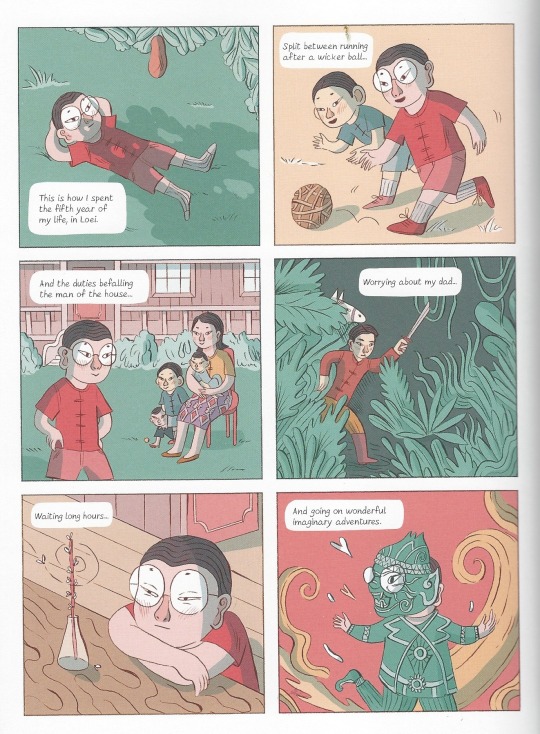
I must confess that I am pretty ignorant of Thailand’s history. While reading this, I wished I had some background of political contexts of Sompong’s personal history. For part of his childhood, Sompong, his mother and siblings moved to an obscure part of the rural countryside while his father was involved with a political conflict that I know nothing about. I also have no idea why Thai military student getting to study abroad opportunity in the late 1930s would be stationed with members of the Axis in World War 2. But mostly that did not interfere with my enjoyment of the story. It’s a great uncle share his life with someone two generations and partially from a different country. For that alone it’s worth reading.
0 notes
Text
Oh, The Swan is actually even worse than that!!
Most of each season is spent taking two women per episode and giving them a bunch of cosmetic procedures, putting them on an extreme diet, and making them work out frequently, all in the span of 3 months, with them isolated in apartments where there are no reflective surfaces (mirrors uninstalled, windows frosted, etc.) so you get to see their shocked reactions at the end of the 12 weeks
A lot of the women went into it bc they just wanted one or two things here or there or even things related to medical conditions and ended up pressured into getting way more than they originally wanted (e.g. someone with PCOS mainly wanting laser hair removal but also being pushed to get breast augmentation, a brow lift, veneers, and so on) and being framed by the show as uncooperative brats when they turn down any suggestions from the doctors
They also get treated as uncooperative brats when they try to turn down a session at the gym, bc yes, they still have to work out regularly and eat the bare minimum of calories while healing from having a fuckton of surgery!! There's a scene where someone has a compression garment around her face and is still at the gym
And while they're cooped up in that apartment, they have 1 person from their personal lives they can call for support -- sometimes it can be kinda wholesome, like a widow calling her teenage sons who adore her or a woman calling her sister who is an absolute cheerleader for her, but there's too many women on that show who call a grumpy bf or a husband who doesn't even pick up
And also in all of that, they get ONE hour per week of "therapy" that isn't therapy bc a) it's being televised and therefore lacks the confidentiality of real therapy, and b) iirc, it's just a producer talking to them about their feelings purely to create material for the show, with no benefit to the "client"??
The reason they do 2 women per episode is bc they pick one with the "worse" transformation to just go home and try to live her life like she hasn't just had ten thousand plastic surgeries and they pick one with the "better" transformation to compete in a pageant!! Half of the women shown to you are now competing for a title at the end of the season, which I don't think they were told about when casting for the first season?? I think I've also heard of "lost swans" who received the makeover but whose footage never aired, but I don't really know anything further than that
Luxeria on YouTube did a reaction/commentary series covering The Swan (girls!) if you wanna learn more!!
I do have to impress on anyone who wasn't around for it how batshit the reality boom of the 2000s could be. Especially on Fox.
Here are some 100% real 2000s reality shows:
Who's Your Daddy? A woman has to guess which of eight men is her biological father. One of them really is, and if she guesses right she wins $100,000. If one of the seven fake dads convinces her to guess them, he wins $100,000.
Black. White. A white family learns about racism by living a month in blackface, while a black family spends a month in whiteface. The black family was a real family, but the white family was just some actors hired to put on blackface to prove racism exists
Without Prejudice? Five strangers decide which of five strangers gets a cash prize based off clips and their answers to political questions. Cancelled when one of the choosers openly said he'd eliminate all black contestants
Welcome to the Neighborhood. Three conservative white families in a Austin subdivision decide which diverse family gets to move in. Unaired due to being literal housing discrimination
Seriously, Dude, I'm Gay. Two straight men try to pass themselves off as gay and whoever seems more gay gets $50,000. Unaired due to. Due to. Due to
Playing It Straight. A woman tries to find love among fourteen men, half of whom are straight and half of whom are gay, and she must eliminate two men she believes are gay each week. If she ended up picking a straight man in the end, they'd split a million dollars; if she picked a gay man, he'd win a million dollars
Boy Meets Boy. This was Playing It Straight but starring a gay man and he had to eliminate straight people
Who Wants to Marry a Multimillionaire? He wasn't a multimillionaire. He didn't even have a million dollars in liquid assets. He had a battery conviction Fox claims they didn't see. Because it was the 2000s, somehow this ended up with the woman he won being widely vilified and turned into a national punchline. How dare she complain about a massive corporation tricking her into marrying a lying abuser, good thing Matt Lauer's there to take her down a peg
The Swan. A "ugly" woman is given plastic surgery and wins a prize if she's the hottest at the end of the season. If she's not hot enough by the show's standards she's eliminated and called ugly on national TV
The Biggest Loser. Overweight people engage in competitive crash weight loss that often led to awful health complications. Studies showed basically everyone on the show regained any weight they lost once it was over and they didn't have abusive trainers demanding they take huge health risks to win a competitive weight loss competition. Like the others, this one was cancel-oh, it was a massive hit that ran for 18 seasons? Yikes!
Wife Swap and Trading Spouses. These were the same show and had a wife from one family go to another family that was different politically, racially, culturally, religiously etc. Most famous for the God Warrior
At the time people focused on the likes of Fear Factor but looking back it's wild how many of the worst shows toyed with politics. So many of these shows have a premise that's like "what if we exposed these conservatives to these people they hate?" or hyping themselves up as Important Experiments. Then they'd freak out when they got the kind of viral bigoted freakout they were trying to construct the whole time.
There were also a bunch of horrible reality shows, thankfully this time mostly unpopular, in the 2010s that based themselves around economic themes as a response to the market crash, but that's a story for another time
#eating disorders /#just in case#bc i mentioned the dieting and working out#id also like to see luxeria cover britains missing top model#they only made one season (i wonder why) and its hard to find (i wonder why) and ive never even seen footage of it myself#but someone i watch on youtube was on it when she was 19#and its britains next top model but everyone is disabled#and then it became an extra layer of someone not just being your competitor#but also trying to create a metric of whether youre more deserving of a position on a show about disability than other people#and the person i watch on youtube said she was bullied by the other models bc 'chronic fatigue syndrome isnt a real disability'#and 'i was born deaf but you didnt become deaf until you were teenager so im a real deaf person but you arent'#she said it was one of the worst experiences of her life#and thats saying something when you consider she was in a psych ward for a month bc eating the wrong foods make her interally bleed
27K notes
·
View notes
Photo

You can’t normalize non-monogamy without de-normalizing monogamy. This doesn’t mean vilifying monogamous relationships—monogamy can exist peacefully in a world where non-monogamy is also an accepted social norm. (Note that nothing in the right column excludes monogamous relationships.) What we’re advocating for, and what we know a unifying flag will help us achieve, is to dismantle the notions that: 1) Fulfillment can’t exist outside of the traditional monogamous structure. 2) Relationships that deviate from that structure are wrong or abnormal. 👉 more stuff at the link in bio! 👉 DM us an intro with your skillset to tell us how you can help our team of volunteers! 👉 what you can expect from this page: • polyamorous & nonmonogamous content • pride flag & flag design content • relationship advice & self-love content • information & updates about our initiative Thank you so much for following. You and your participation are so, so valuable to us.
~image description below~
[Image Description: A single square images. All text is in lowercase letters, and centered, excluding the title of the image. The image is split into two halves. The left half is white while the right half is pink. The text at the top of the image is in big, bold black letters and reads “dismantling”, directly beneath it is a black box extending from the left side of the image with big, bold white text which reads “mono-normativity.” Beneath it is more text. Some slightly smaller, bold black text in the white half of the image reads “how it is.” and has a small, black horizontal line under it. To the right side of this text, over in the pink area is bold white text which reads “how it should be.” with a small, white horizontal line under it. Both sides have a list of sentences under their respective text. The for both sides is smaller, thin black text. The first line under “how it is” reads “your identity is assigned to you.” The corresponding line under “how it should be” reads “you earn & explore the world, others & yourself.” The second line under “how it is” reads “you’re expected to find a romantic partner.” The corresponding line under “how it should be” reads “you seek &find fulfillment in the ways that work best for you.” The third line under “how it is” reads “you’re expected to ride the relationship escalator & “fail” a few times, whether it feels right or not.” The corresponding line under “how it should be” reads “you choose whom you’ll dedicate your time to, & what those relationships will look & feel like.” The fourth line under “how it is” reads “you find “the one”- one person who can meet all your nuanced needs and who agrees to meet yours.” The corresponding line under “how it should be” reads “you continue to explore, craft, change, & augment your own identity over the course of your life.” At the bottom right corner is the “@polyamproud” watermark with the polycule symbol next to it in gray.
End ID.]
#polyam#polyamorous#polyamory#polyam pride#polyamorous pride#polyamory pride#polyam relationship#relationships#polyamorous relationships#polyamory relationships#nonmonogamy#non-monogamy
33 notes
·
View notes
Text
How to Play as Link in DnD 5e (2.0)
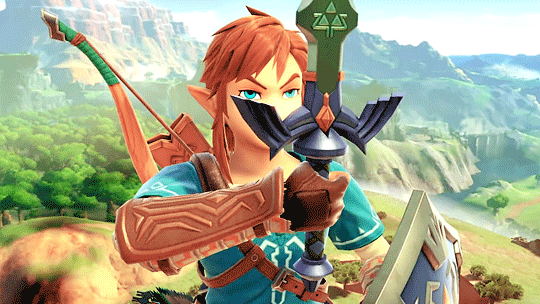
With the release of both Mythic Odysseys of Theros and now the new big expansion in Tasha’s Cauldron of Everything, I figured now would be a good time to reexamine Link with the context of new subclasses, class features, and game mechanics that weren’t around the last time that I built him. While I won’t do this for every character I’ve built before, characters who have new options made available with these updates will get a new rebuild for 2021. If you want to compare and contrast this build to the original, I will link that build right [here].
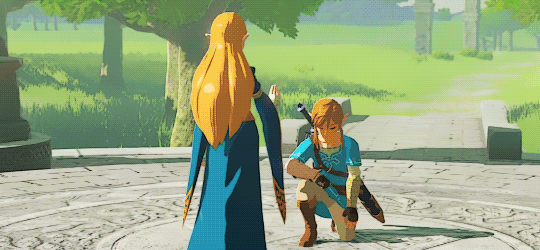
The Spirit of the Hero
Link’s a Hylian and that’s just a fancy way of saying elf. His best racial options are either the High Elf, the Wood Elf, or the Half-Elf. Half-elf’s extra skills are tempting, but as Link is never given any parents or an ancestral family tree, we can’t really justify him as a half-elf. We’ll call him a Wood Elf for the extra +2 to his Dexterity and the +1 to his Wisdom as well as that woodsy vibe. But if you wanna go for a Half-Elf for the power build, I won’t tell anyone.
Link’s alignment is tricky. On the one hand, he is shown kneeling before the monarchy, defeating the forces of evil and darkness, and doing odd jobs to help the common people he comes across. However, he can also start forest fires, break into people’s houses, smash pots, steal people’s life savings or personal belongings, and attack the chicken population until they attack back. I’d wager he’s Neutral Good if for no other reason than his morality is highly dependent on the player.
My first choice for Link’s background would be the Folk Hero for Animal Handling and Survival. However, Link’s background is so inconsistent, it’s easier to just list out the skills he tends to have and tell you to pick a background that has those skills, or create your own: Animal Handling, Athletics, Investigation, Nature, Perception, or Survival. There’s a case to be made for other skills as well. Acrobatics works a little and his jumps did involve sick flips in Majora’s Mask, but Link doesn’t tend to balance or platform jump very often. Link can play instruments fine and danced in the Subrosian Dance Hall in Oracle of Seasons for Performance proficiency, but he’s usually playing instruments to activate effects, not to actually perform for a crowd. Link shows some Stealth skills in Breath of the Wild, but this hasn’t been a longstanding skill of his, so I didn’t lump it in with his main skill list.

Becoming a Hero
When it comes to his build, Link has made some use of spells in the past, but he’s nowhere near the spellcaster that Zelda and Ganondorf are. Link is definitely more of a martial fighter who augments himself with a wide arsenal of magical items. So when it comes to picking Link’s class, we have a few things to keep in mind.
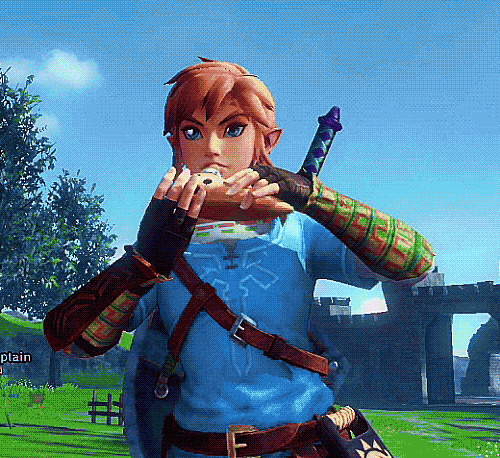
BARD
Link is a talented young man, and he has had magical instruments in a few games over the years, as well as dancing in Subrosia, among other things. While I don’t subscribe to the idea of Link being a bard myself, I understand why people would come to this conclusion, as Link isn’t really bad at anything... except talking. And lying. And looking threatening. Or haggling. Yeah kind of hard to depict Link as a CHA caster who isn’t proficient in any CHA skill checks.
Spirits (UA) This doesn’t fit for every Link, but especially for Breath of the Wild where Link gets help from the spirits of his fallen comrades, the flavor of calling on the dead works for Link. For a non-BotW example, maybe Link can tell stories of his past lives, and the memories he shares with each of them.
Valor This college has the downside of being built as a cheerleader, while Link really should be built for solo-combat since that’s how he approaches most fights. But Valor is better than Swords and also gives Link proficiency with martial weapons and shields, while Swords does not.
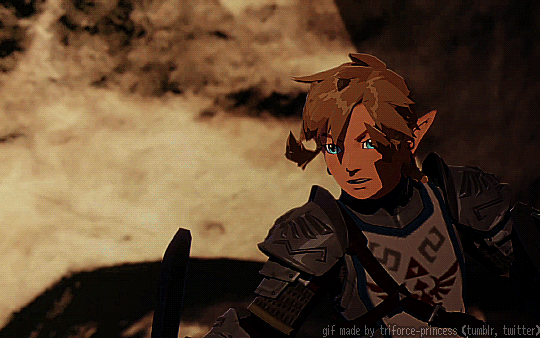
FIGHTER
While there are many martial classes, the Fighter differentiates itself by being the most down-to-earth option. It’s not beholden to rage, or smites, hunting, or sneaking. It is the simple skill of the blade, and this is a skill Link has in spades. From the earliest games, Link has been a master of the sword, the shield, and the bow.
Battle Master Link is a strategic fighter. He looks for weak spots, and he exploits them the best he can. Of all the fighter subclasses, none is more clever than the Battle Master. Its many maneuvers resembles the numerous sword techniques Link has learned especially in the later games. Even in Smash, Link showcases how clever he is by being able to combine his arrows with his bombs and shoot a bomb arrow. To my knowledge, none of the other characters can combine their abilities like this in Smash.
Cavalier The subclass is poorly named, and was better in its initial name as the Knight, as that is really what this subclass is. It is the idea of the knight in shining armor. They can also be flavored as bodyguards, a traveling sellsword, or castle guards. So Link does not have to be glued to Epona to make use of this subclass. The main reason to want this subclass is the Warding Maneuver, as giving Link the chance to either block or reduce all damage he takes is going to seriously improve how well he can tank a hit, and help keep him in a fight longer.
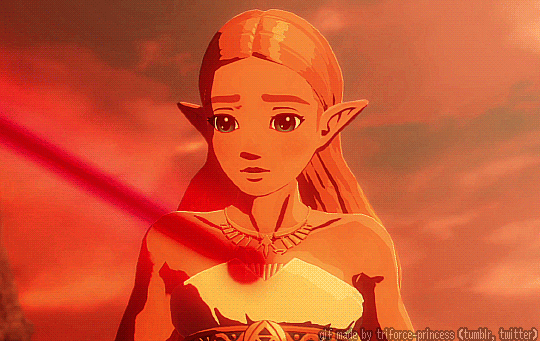
PALADIN
More than any other class, the Paladin actually stands for something. They fight for a value or a belief. They swear their life to a cause and are prepared to die fighting for it. Link works on a lore level as a Paladin. Especially when he’s dedicated multiple lifetimes to the same cause. Across every timeline and game over screen, Link has always returned and stood in defiance against whatever evil may come.
Ancients This oath makes Link sworn to the forces of nature, such as the Great Fairy, and protecting the balance and harmony of the light, life, and love against death, decay, and darkness. The Ancients Paladin is all about protecting the balance in the world and valiantly opposing evil wherever it might arise. It also has a druidic or fey aspect, which kind of works for Link.
Crown With this vow, Link serves the Hyrulian Royal Family. This makes Link the princess’ personal knight, and an agent of lawfulness, order, and peacekeeping in the land. While 5e has backed away from typecasting Paladins as Lawful Good, this is probably the most Lawful subclass one could pick, as it places the authority of the royal family above all else.
Glory Instead of being sworn to the light or the law, the Glory Paladin is the harbinger of the goddesses. They are flavored as legendary heroes of destiny, possibly being demigods or the personal errand boys of the setting’s pantheon. This subclass is clearly focused on being a frontline warrior, and the features make Link a true force on the battlefield.
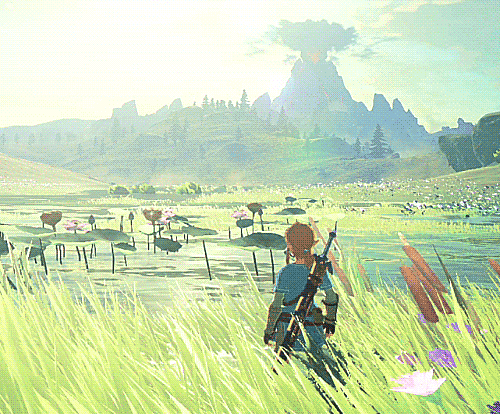
RANGER
Anyone who’s played Legend of Zelda knows that Link is very good at surviving. The games don’t tell you how to navigate the wilderness, Link just has to figure it out for himself. What’s more, Link may be willing to venture into the wilderness, but he’ll be hard-pressed to find many NPCs that far outside of settlements or cities. Yet what they fear, he thrives in. And it’s no wonder that this is the class most peole would assume for Link.
Hunter This conclave is the slayer of all things that threaten civilization. They can choose to be better at chipping away at one enemy, counter attack bigger monsters, or mow through hordes of minions with more ease by taking out multiple at a time. Especially at higher levels, this conclave excels at ripping apart Ganon’s forces with nary a golden curl out of place.
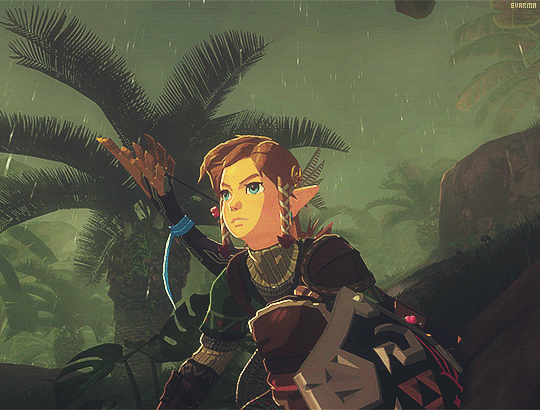
ROGUE
The rogue doesn’t need to be a wanted criminal on the lamb. They can be a clever fighter with a variety of skills and a knack for evasion. That speaks a lot more to Link’s skill set than one might assume at first glance. It’s not a perfect fit for Link, but it’s really not that inaccurate either.
Inquisitive This roguish archetype is defined by being clever in combat, looking for weak points to exploit. They’re also much more observant, making them better at discovering clues or secret passages, or telling when they’re being misled. At higher levels, their ability to look for weaknesses can even increase their sneak attack damage. This especially fits some of the older games where boss fights were focused on using items to exploit the dungeon boss’ weaknesses, rather than hacking away at their health bar. In these older titles, Link was less of a straight up warrior and more of a clever trickster pulling off strategic victories.
Scout The Scout Rogue has heavy Ranger vibes, as they get free expertise in Nature and Survival, enhanced mobility, the ability to disengage from fights more easily, and at higher levels become masters of ambushes. This fits well with Link’s sneakier sniper playstyle that can be done in Breath of the Wild, as Link can take out entire camps without ever being seen.
Thief While Link is not a standard cutpurse, Link is a treasure hunter, a dungeon delver, and the jokes about him robbing the people of Hyrule and breaking into people’s homes doesn’t exactly help. The thief also gets to use more magical items, allowing Link to use things such as enchanted instruments without being a bard.
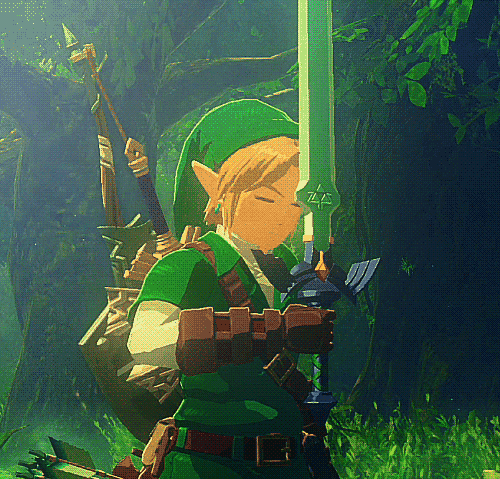
WARLOCK
Link usually isn’t the hero of his own volition. He often starts his journey with Triforce of Courage, a source of power gifted by his patrons. It’s honestly a weak connection, but it loosely works, so I’m including it.
Celestial While this subclass is geared toward serving something other than a god, I don’t see any reason why a Celestial Warlock couldn’t serve the Triple Goddesses of Hyrule or even Hylia/Zelda directly.
Hexblade The most obviously martial warlock option, this is a good choice if you want to incorporate Fi into your character.
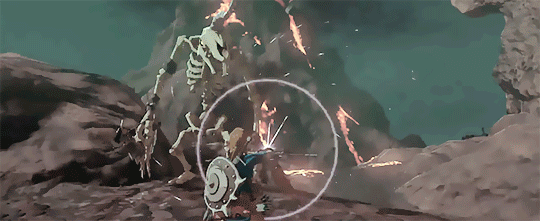
Link’s Toy Chest
Hero’s Sword - Longsword (+1-3) Mirror Shield - Repulsion Shield Hero’s Bow - Oathbow Gale Boomerang - Storm Boomerang Fire Rod - Wand of Fireballs (requires spellcasting) Mastersword - Sword of Zariel, Holy Avenger Longsword* Hylian Shield - Shield of the Hidden Lord Goddess Bow - Ephixis, Bow of Nylea Golden Gauntlets - Gauntlets of Ogre Power Zora Tunic - Cloak of the Manta Ray Pegasus Boots - Boots of Speed Hover Boots - Boots of Levitation Hook Shot - Rope of Climbing
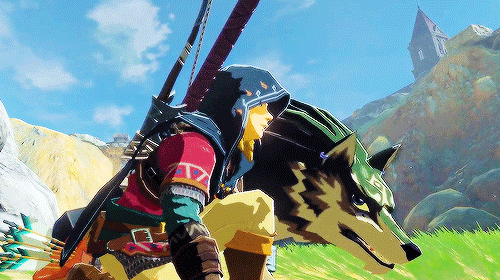
SIDEKICKS
Sidekicks are a new edition from Tasha’s that let Link bring allies on his hero’s journey. Experts are skill monkeys who focus on Help actions, Spellcasters dip into the INT, WIS, or CHA spell lists, and Warriors are trained to fight and don’t have to talk, so they can be animals.
Epona - Defender Warrior Riding Horse Navi - Expert or Healer Spellcaster Sprite Sidon - Attacker Warrior Merfolk Sheik - Expert Noble (Elf) Wolf Link - Attacker Warrior Wolf
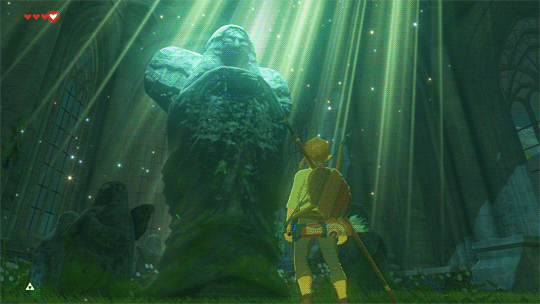
Theros Piety
The Piety System from Theros lets us be devout to a god and earn features from worshiping them. As far as I’m aware, this is an optional feature, and not every DM will make use of these, but if you’re able to, here’s a handy guide. These gods really stood out as the clear choices for Link to go with.
Iroas - God of Victory
Domains: War Virtues: Achieve a great victory, Overcome slim odds honorably, Defeat a foe in single combat, Perform a great feat of strength or skill Sins: Being a coward in battle, Beat an honorable foe through deceit, harm innocents Piety Bonus: +3 Learn Compelled Duel spell +10 Learn Crusader’s Mantle spell +25 For 1 minute, creatures cannot gain advantage on you +50 Increase STR or CHA by 2 to a max of 22
Keranos - God of Storms
Domains: Knowledge, Tempest Virtues: Solve a riddle or puzzle, defeat an unwise enemy, plan ahead for an upcoming challenge, build or restore a temple to Keranos Sins: Jeopardize others through foolishness, ignore a wise course of action, fail to plan for a challenge, give in to anger or self-destruction
Piety Bonus: +3 Add 1d6 lightning damage to melee attack up to INT mod turns. +10 Reroll a failed INT or WIS saving throw +25 Advantage on Initiative rolls +50 Increase INT or WIS by 2 to a max of 22
Nylea - Goddess of the Wild
Domains: Nature Virtues: Help any wild animal, stop those who hunt for sport or profit, win an archery competition, slay an aberration, fiend, or undead Sins: Kill an animal without reason, Dedicate a building to or make a sacrifice for any god (including Nylea), protect a city from a natural disaster
Piety Bonus: +3 Learn Hunter’s Mark +10 Learn Speak with Animals +25 Attacking creatures must pass DC 15 WIS save or change targets. +50 Increase DEX or WIS by 2 to a max of 22
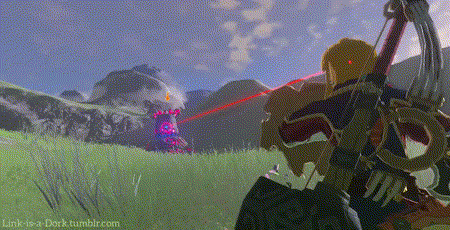
Cunning Tactician
Battle Master Fighter (12) Inquisitive Rogue (8) Fighting Style: Dueling Maneuvers: Brace, Disarming Strike, Feinting Attack, Parry, Precision Attack, Riposte, Sweeping Attack Tools: Thieves’ Tools, Mason’s Tools
While Link is brave and strong, he is most defined by his clever mind and unorthodox solutions to boss fights. With this class split, Link has prioritized strategy and tactics over everything else. While it leaves him a little squishier, Link is still a very capable warrior. As a Battle Master, he got a free tool proficiency. Mason’s Tools allows Link to find secret passageways in stone walls, which most dungeons tend to be made of. On top of that, with his Feinting Attack, Link can give himself advantage, meaning he can use Sneak Attack even in a 1v1 fight, which fits his solo adventurer playstyle.
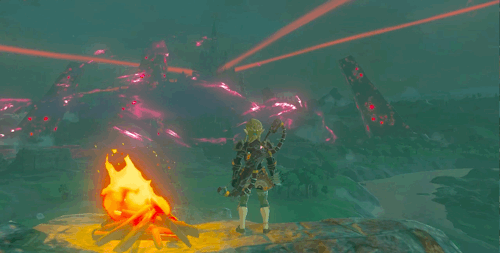
One-Man Army
Battle Master Fighter (12) Hunter Ranger (8) Fighting Style: Dueling, Archery Maneuvers: Brace, Disarming Strike, Feinting Attack, Parry, Precision Attack, Riposte, Sweeping Attack Hunter’s Prey: Colossus Slayer, Multiattack Defense Tools: Mason’s Tools
I used this build once in a level 10 campaign. 6 levels of Fighter, 4 levels of Ranger with a +2 Longsword, and let me tell you something. This build creamed the competition, which was the other PCs at the table, who were also built as level 10 characters. Link nearly defeated his first opponent in a single round, dealing around 70 damage between his four attacks. When I say this is Link’s “power” build, I mean it. I didn’t even sweat when an adult blue dragon showed up after the tournament ended, that’s how much faith I had in Link’s ability to fight. I honestly forgot to even use Link’s battle maneuvers, he was just dealing so much damage that it slipped my mind. You could swap Battle Master for Cavalier, but for me, the Battle Master is more accurate to Link’s favor of techniques over basic hack-and-slash.
RANGER SPELLS
1 Absorb Elements, Ensnaring Strike, Hunter’s Mark 2 Cordon of Arrows, Healing Spirit
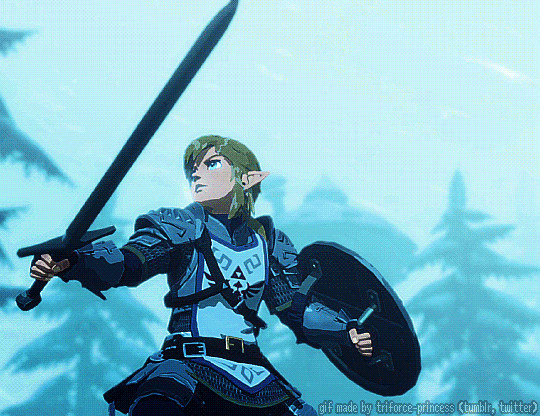
The Hero of Hyrule
Battle Master Fighter (12) Glory Paladin (8) Fighting Style: Archery, Dueling Maneuvers: Brace, Disarming Strike, Feinting Attack, Parry, Precision Attack, Riposte, Sweeping Attack Tools: Mason’s Tools
As a Glory Paladin, Link is driven by a desire to be a legendary hero, and at least in the UA version, the Glory Paladin served the gods, as Link does. Like the two builds above, Link balances the brute might of the Glory Paladin with the tactile diversity of the Battle Master.
PALADIN SPELLS
1 Cure Wounds, Divine Favor, Guiding Bolt, Heroism, Protection from Evil and Good, Searing Smite, Thunderous Smite, Wrathful Smite 2 Branding Smite, Enhance Ability, Find Steed, Magic Weapon, Warding Bond
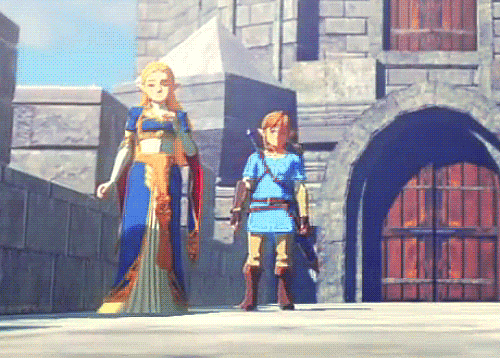
Oaths and Promises
Glory Paladin (12) Celestial Warlock (8) Fighting Style: Dueling Pact: Blade Invocations: Eldritch Smite, Improved Pact Weapon, Maddening Hex, Relentless Hex
The builds from here on are more for the flavor than necessarily Link’s character. As a Blade Pact Paladock, Link becomes a CHA-focused martial with some extra spell slots that turn his smiting sword strikes into a bokoblin slurry machine. This build focuses Link more as a servant of the gods than anything else. Just make sure he has the Hex spell, but you can replace Maddening Hex with Agonizing Blast if you want to use the Master Sword laser beam at full potential.
PALADIN SPELLS
1 Divine Favor, Guiding Bolt, Heroism, Protection from Evil and Good, Searing Smite, Thunderous Smite, Wrathful Smite 2 Branding Smite, Enhance Ability, Find Steed, Magic Weapon, Warding Bond 3 Blinding Smite, Crusader’s Mantle, Elemental Weapon, Haste, Protection from Energy
WARLOCK SPELLS
C Blade Ward, Booming Blade, Sword Burst 1 Armor of Agathys, Cure Wounds, Hex 2 Lesser Restoration, Misty Step, Shatter 3 Spirit Shroud, Summon Fey 4 Galder’s Speedy Courier
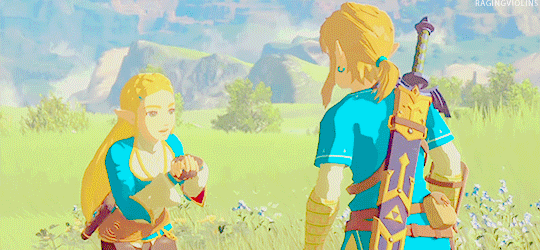
To Serve and Protect
Battle Master Fighter (12) Crown Paladin (8) Fighting Style: Dueling, Interception Maneuvers: Bait and Switch, Brace, Disarming Strike, Goading Strike, Parry, Riposte, Sweeping Attack Tools: Mason’s Tools
Link is Zelda’s knight, bodyguard, and servant. So this build prioritizes features that makes Link the loyal emissary of the Princess of Hyrule. As such, this build changes Link’s role to be more of a defender to the princess than a solo hero. This build assumes that the princess or someone else who needs to be protected is joining Link on his adventure.
PALADIN SPELLS
1 Command, Cure Wounds, Divine Favor, Heroism, Compelled Duel, Searing Smite, Thunderous Smite, Wrathful Smite 2 Branding Smite, Find Steed, Warding Bond, Zone of Truth
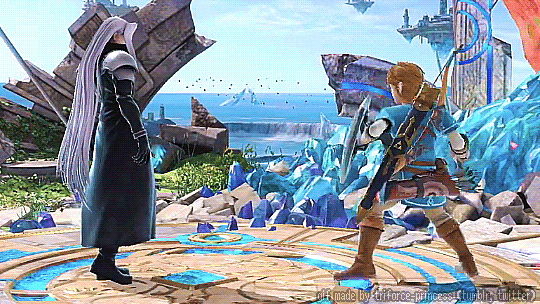
After all is said and done, I hope I gave everyone a lot to work with. Of course my suggestions are not law, and if nothing else, I hope it gives you an idea of how you want to build him. Last time I built Link, I gave one set build for him, but I still laid out other options. Recently though, I’ve been trying to show multiple builds at the end of my build posts to offer a wider idea of what building a character can look like. Happy 2021 everyone, and let’s hope this year goes smoother.
#legend of zelda#the legend of zelda#link#the hero of time#spirit of the hero#hyrule#hero of hyrule#princess zelda#dnd#dnd 5e#dnd fifth edition#dnd 5th edition#tashas cauldron of everything#tcoe#Fifth Edition#5th edition#dungeons & dragons#Dungeons and Dragons#breath of the wild#botw#dungeons and dragons fifth edition#dungeons and dragons 5th edition#botw2#triforce#triforce of courage#loz#nintendo#zelda#ocarina of time#majoras mask
236 notes
·
View notes
Text
Title: Guilt
Rating: Teen and Up
Fandom: JoJo's Bizarre Adventure: Stardust Crusaders (set after Golden Wind, given Jolyne's age.)
Pairing(s): JotaKak, JoKa, (Platonic) Jotaro & Jolyne, (Platonic) Kakyoin & Jolyne
Summary: Kakyoin is in the middle of answering one of Jolyne's many questions when he feels something twist violently inside his abdomen. He tastes what he thinks might be bile at rist, but the metallic tinge registers, and,
Oh god, no. Not here. Please not here.
Notes: Involves emergency surgery, chronic pain, preteen!Jolyne, PTSD, disabled Kakyoin, and near death experiences.
-
Here's the thing: Jolyne hates him. It's not a secret, and it's definitely not something that she bothers to hide from him. Jotaro keeps swearing that she'll come around. Says she's just stubborn (like her father is, Kakyoin sometimes thinks with far too much affection for a man that regularly drives him up the wall). There's also the fact that she's a preteen, and kids are apparently just like that at her age.
Here's the thing: Kakyoin would hate him, too. If he were in her situation. He's petty on a good day, and a right bastard on any other. He can't imagine being in her situation. With divorced parents who, while amicable, are both ridiculously successful and constantly busy. And then waltzed in Kakyoin, right in the middle of it. Though 'waltz' is a bit of a stretch. He doesn't do anything like that with his plated spine and braced legs, but none of that matters. The real point is that he gets it.
He does his best to never push more than he has to. For the most part, he lets Jolyne do her own thing, because she's a Kujo and a Joestar. She's going to do what she wants anyways. His opinion be damned, though he does try to reason with her. Hell, he's given into bribing every once in a while. (Sometimes the means don't matter when father and daughter are both happy at the end of the day.)
In short: Jolyne hates him, and Kakyoin understands.
______
Here's the thing: Jolyne finds Kakyoin to be a nuisance. An interference. One more complication to an already complicated life, and she's only eleven. She wants her parents to get over their bullshit (language!) and figure out how to make things work. She wants Kakyoin to go away, but that doesn't mean she wants him dead. Or injured. Even if she did wish him off the end of a pier that one time. Still.
They've admittedly grown to be more friendly over time. She talks to him now, which is an improvement to the chronic cold shoulder she gave him before. Sometimes she even asks him for help, because her dad can be surprisingly useless when it comes to school work (weren't you in school when I was little?) He always seems happy to help, and he never gets as frustrated as her dad.
So maybe she doesn't hate him, but she definitely wants him to go away.
______
Kakyoin is in the middle of answering one of Jolyne's many questions when he feels something twist violently inside his abdomen. He tastes what he thinks might be bile at rist, but the metallic tinge registers, and,
Oh god, no. Not here. Please not here.
He doesn't need to know-- specifically-- what went wrong to know that he's dying. The moment the pain goes from barely tolerable to utterly agonizing is about when his brain lets him know that he's operating on borrowed time.
Kakyoin could have used that warning approximately five minutes ago. Before the pain. Before he found himself in front of Jolyne.
"I'm sorry," he tries to say, hopes the words come out audible enough for her to understand.
There are tears welling up in her eyes, and they fall soon enough. God, he's made Jolyne cry. She's so young. So unprepared. And she looks so much like Jotaro. With panic stricken eyes and fingers that grasp for something to do. Some way to fix this. It makes his chest ache beyond the twisting and shearing that his insides are already doing.
(She looks exactly like Jotaro, in the hospital after the Foundation managed to retrieve them. The way her hands fumble in the air is so much like how Jotaro had reached out desperately, trying to hold onto Kakyoin, in case those had been his last moments. Like father, like daughter, Kakyoin thinks without humor.)
His knees hit the ground first, and that shoots pain up his legs and along his hips. The rest of it ricochets and dies somewhere midway up his spine. It's a momentary distraction away from the agony that is his middle. He reaches with his fingers to press against his stomach, half expecting them to sink inward (into nothingness. There's nothing. Dio punched a hole right through him, and he's going to die.)
Jolyne is yelling. His name at first, then for her father. Again, he's reminded of the day he died. Maybe it's all been a dream. He's waking up now and the end is pressing down on him. The light will follow soon. He knows; he's seen it before.
"Please!" Jolyne begs him, "I'm sorry!"
He is, too. It's the last thing he thinks before his eyes slide shut and the darkness grabs at him greedily.
______
There's shouting and bright lights and something covering his face. He can't make out anything with his vision so blurry, but he thinks he hears Jotaro's angry voice booming what could be an entire room away.
"If you fucking put a finger on him that isn't necessary to keep him alive. I'll fuck-"
"Dad!"
Jotaro inhales sharply but nods to the surgeon one, final time, "His team is on their way. Not a goddamn finger."
______
The Speedwagon Foundation has several doctors that Kakyoin sees on a semi-regular basis. Each is a specialist in their own right, and they're the only reason Kakyoin ever made it home from Egypt. They're also the only ones that regularly work on updating all the augmented parts and maintaining the damaged remains of Kakyoin's organs. They know him inside and out. Quite literally.
The team makes it to the hospital long before Kakyoin comes out of emergency surgery, which means the whole process is extended significantly. The upside (if it could be called that) is that Kakyoin doesn't have to be put under again. The downside is that it means they'll be waiting awhile.
Jotaro does his best to be strong for Jolyne. It's his job as a parent to keep a calm façade and push his emotions to the side. She needs someone to be her reassurance.
He fails miserably.
______
The head of the Foundation team emerges some hours later, looking a little worse for wear. The stoicism past that does little for Jotaro's nerves. It tells him nothing of what to expect.
"Well?"
"He's stable," the doctor answers. "We had to take out several inches of colon this time. If I had to guess, he probably believed himself to be having a flare. He adjusted to the pain until he became necrotic." His expression shifts into an unpleased frown, "He also has two ulcers. Has he changed his diet? Or experienced any new stressors?"
Jolyne's lip quivered as she processed the doctor's words. She thought over every time she and Kakyoin had fought in recent history. Most of it being her yelling at him.
Jotaro's focus remains fixated on the doctor, "What the hell kind of pain is he still having?"
The doctor-- one Jotaro recognizes from previous visits but can't recall the name of-- sighs, "Kakyoin will only allow us to do so much to help manage his pain. I'm not his specialist in that regard, but it's at his request that he's kept on very little in terms of medication."
Jotaro knows that. He knows that Kakyoin doesn't like what stronger pain meds do to his head, but how out of control is his pain that he didn't notice that he was dying? That his body has been rotting from the inside out for an unknown amount of time?
Jolyne shifts further behind him, drawing his attention to her. It's the only thing that spares the doctor whatever response Jotaro might have otherwise formed. He turns to look at Jolyne and is startled by the tears already trailing down her round cheeks. Realization hits him then.
She's eleven, and he's an idiot.
"Hey, hey. Enough with that. He's going to be okay," Jotaro says quickly. He should have- called her mother or his mother or literally anyone. This isn't a conversation she needed to be privy to.
"It's me," Jolyne chokes the words out. Her thin arms wrap tight around her middle, and she looks close to collapsing on the ground.
Jotaro, admittedly, has no idea what she's talking about, "What's you?"
"The stress!" She practically wails.
Jotaro sighs and moves to wrap his arms around Jolyne. He tugs her in against his chest. "That- that's not the kind of stress the doctor is talking about," he glances over his shoulder to see that the man had already dismissed himself. Smart guy.
"I'm always mean to him!"
Jotaro wants to laugh. Not at all because he thinks her words-- or her suffering-- are funny, but because the whole situation feels unreal. He cards his fingers through her hair instead. It's all the comfort he feels like he can offer in a situation like this. With his own resolve teetering on the edge.
"Takes a lot more than that to take out Noriaki," he's lying through his teeth. The whole new family thing might damn well be enough stress, but he's never going to let Jolyne think this is her fault. It's not. Kakyoin is capable of making his own decisions, and being part of their family is one of them.
Jolyne crumbles against him despite the gentle words, so he scoops her up and holds her against his chest. Even at eleven, she's nothing compared to his size. He finds a nearby seat to settle into and lets her cry while he whispers promises he can't be sure he'll be able to keep. Eventually he tries distracting her with facts about dolphins, and that either has some effect, or she passes out from exhaustion. Either way, he's relieved when she snores against his neck.
______
Kakyoin comes to the waking world in a haze. His head aches and his middle feels a lot like it might have been ripped open again. He hopes that whatever happened had been a little more civil than that.
It doesn't take him long to place himself in the hospital. That's good. He isn't dead, and he's not immediately at risk of falling into enemy hands. The beeping to his left is annoying, and he can't see well enough to make anything out on the monitors around him. His vision tends to be the last thing to recover when he's been knocked out for a while. Still, he turns his head to continue to take in what he can make out.
He stops short when he sees two people in chairs on his right side, closer to the door. The familiar hat catches his attention immediately, not that he needs to be able to see at one hundred percent (or his version of it) to know that the man is none other than Jotaro. His size will always give him away before anything else.
Jotaro's head is bowed in a way that indicates he's likely asleep. He's undoubtedly been here awhile. Jolyne sits beside him with her head pressed against her father's bicep. Star Platinum is out and wrapped around both of them. He lifts his hand from Jotaro a moment to wave at him brightly, which is enough to disturb his user's sleep.
"Mm?" Jotaro grunts. He opens his eyes and sucks in a breath. He takes a moment to compose himself, which is fine. Kakyoin thinks he probably looks worse than he feels, thanks to the drugs. He would make a joke about it, but moving still hurts.
"Good to see you awake. How're you feeling?" Jotaro asks. He doesn't move from his spot, if only to avoid waking up Jolyne, but that intense gaze is evaluating all the same.
Kakyoin gives a noncommittal answer, and Jotaro snorts, "That's what I thought you'd say. Good thing we have this." He reaches for the little controller on the side of Kakyoin's bed. He presses the red button before Kakyoin can protest.
The glare he shoots Jotaro is relatively short-lived, and it's hard to be mad when Jotaro looks so damn triumphant, even if it's about something that Kakyoin has complicated feelings about. He decides to let him have this one, considering the fact that he's pretty sure he gave them all one nightmarish scare.
"I'm sorry," he says after a while, head lulling back against the pillows. His red hair spreads out all around. It's longer now than it ever has been, but he hasn't felt the need to cut it beyond a simple trim in years. It doesn't matter, but it gives himself something to focus on rather than the gnawing guilt.
"Don't be."
"I- god, I never meant-"
"Kakyoin."
"If I had known, I would have left the room or-"
"Kak-"
"She was so afraid. And she-"
"Noriaki," Jotaro snaps more than says the name, but his eyes are soft. "You aren't the only one that made her cry in the last few hours, so you're not special." That's not true. Kakyoin is incredibly special, but he needs to make some kind of light-hearted comment before he starts crying. Nobody needs to see that.
"Still," Kakyoin mumbles, but he doesn't continue.
Jotaro reaches out with Star, who clasps his large hand over one of Kakyoin's. He wants to lean forward himself, but he doesn't want to wake Jolyne up. Not yet.
Kakyoin turns his palm up to tangle his fingers together with Star's. He brushes his thumb over the stand's, knowing Jotaro can feel it reflected on his skin.
"I really thought it was a flare," he says after a while, because he feels like he owes some sort of explanation after everything.
"Nori, I really can't tell you how much I don't give a damn about that," Jotaro frowns at his own words, "No, I mean- I care, but- fuck." He scrubs his hand over his face a few times before trying again, "You don't have to feel guilty for this shit, okay? I should have noticed you were in pain."
Kakyoin shakes his head. He squeezes Star's hand to make sure Jotaro's listening when he speaks, "It's not your fault. I deal with this pain all the time. It just- at first it felt like a flare, but I guess I got used to it." And every time the pain worsened, he acclimated until it had nearly killed him.
Jotaro doesn’t get a chance to respond before Jolyne is rustling against him. She opens her eyes a crack and reaches up to wipe at them with her fists. “Dad?”
“Right here,” Jotaro grunts in response. He squeezes her shoulder gently, then retracts his arm to give her space to stretch out. “Kakyoin is awake.”
He watches the fog clear from her eyes. They widen as she processes his words, and her attention immediately turns to the redhead, who waves meekly at her.
“Jolyne, I’m- oof!”
Star quickly gets his hands around Jolyne’s waist, suspending her in the air enough to keep her weight from falling too heavily onto Kakyoin. He lets her down carefully, and the youngest Kujo looks sheepish for her overreaction.
“Sorry.”
“No, it’s alright,” Kakyoin says, curling an arm around her loosely in return. He hadn’t expected to be nearly tackled upon awakening. That went doubly so when considering Jolyne as a factor. She’s never hugged him before. Trauma is funny in that way; something he knows from first hand experience.
Jotaro steps up behind her and offers a small smile to Kakyoin, “We’re glad you’re alright.”
“Yeah!” Jolyne echoes, “You scared the shit out of us!”
“Jolyne,” Jotaro’s voice is gruff. An attempt at a warning that falls short. The way his lips pull further upward is a dead giveaway that he isn’t particularly upset by her language usage.
“It’s true!”
“Good grief.”
Kakyoin snorts at the father-daughter duo, relieved to see the two smiling again. Already bickering as per usual. There’s too much snark trapped in the Joestar bloodline, and it always amplifies whenever there’s more than one of them in a room. He’d know, having been on the road with Joseph and Jotaro in the past.
Somehow the back and forth settles into Jolyne rambling about dolphins. She regurgitates facts that-- for the most part-- Kakyoin already knows, but he feigns shock and awe at all the right places to keep her spirit up. It’s more healing to watch her babble emphatically than it is lying around in a hospital bed, staring at the ceiling. It eases some of the guilt, makes him feel lighter.
Eventually, Jotaro whiskers her out the door. Kakyoin catches sight of Holly, which must mean that Marina is tied up. Holly doesn’t come in, likely at her son’s behest. The woman is a mother through and through, and she can be a bit overwhelming at times. Better to focus all that maternal energy on Jolyne for now.
“You look tired,” Jotaro says when the door clicks shut behind the two. He takes his spot back next to Kakyoin’s bed, pulling his chair as close as he can. His knees grind against the railing of the bed a bit, but the distance allows him to lean forward and get a good look at his partner.
“I could say the same about you,” Kakyoin points out with a raised brow. He still can’t pick up his head for more than a few seconds at a time, and his vision remains fuzzy around the edges; a likely side effect of being drugged to the gills, but he isn’t blind. He can see the bags collecting under Jotaro’s eyes. Exhaustion-- emotional as much as it is physical-- already weighing his shoulders down.
Jotaro snorts an unamused sound, “I’m not the one that just had emergency surgery.”
Kakyoin winces at the reminder. “I’m-”
“If you finish that statement, I’m going to give you a reason to be sorry,” he isn’t. Jotaro won’t hurt him, but the words make Kakyoin close his mouth anyways. For a second.
“Oh, and how are you going to do that?”
Jotaro stares him down for a solid thirty seconds, expecting him to back down. When he doesn’t, the man pushes himself to his feet with an exasperated sigh. “Good grief, c’mere,” his fingers hook under Kakyoin’s chin, and he leans down to press their lips together.
As far as life affirming kisses go, it’s one of Jotaro’s more gentle ones, but Kakyoin feels the thrill of it chasing down his spine anyways.
“I love you,” Kakyoin murmurs as they break apart. He wants to add an apology to the end, but he bites his lip and keeps it to himself for now. He’ll find a way to make it up to Jotaro and Jolyne later.
“Love you, too, Tenmei.”
#jotakak#jotaro kujo#kakyoin noriaki#noriaki kakyoin#jolyne kujo#jjba#jojo's bizarre adventure#jbba part 3#stardust crusaders#blitzwrites#blitz
39 notes
·
View notes
Photo

Today we remember the passing of Daniel Johnston who Died: September 11, 2019 in Waller, Texas
Daniel Dale Johnston (January 22, 1961 – c. September 11, 2019) was an American singer-songwriter and visual artist regarded as a significant figure in outsider, lo-fi, and alternative music scenes. Most of his work consisted of cassettes recorded alone in his home, and his music was frequently cited for its "pure" and "childlike" qualities.
Johnston spent extended periods in psychiatric institutions and was diagnosed with bipolar disorder. He gathered a local following in the 1980s by passing out tapes of his music while working at a McDonald's in Dobie Center in Austin, Texas. His cult status was propelled when Nirvana's Kurt Cobain was seen wearing a T-shirt that featured artwork from Johnston's 1983 cassette album Hi, How Are You.
Beyond music, Johnston was accomplished as a visual artist, with his illustrations exhibited at various galleries around the world. His struggles with mental illness were the subject of the 2005 documentary The Devil and Daniel Johnston. He died in 2019 of what is suspected to have been a heart attack.
Johnston was born in Sacramento, California, and grew up in New Cumberland, West Virginia. He was the youngest of five children of William Dale "Bill" Johnston (1922–2017) and Mabel Ruth Voyles Johnston (1923–2010). He began recording music in the late 1970s on a $59 Sanyo monaural boombox, singing and playing piano as well as the chord organ. Following graduation from Oak Glen High School, Johnston spent a few weeks at Abilene Christian University in West Texas before dropping out. He later attended the art program at Kent State University, East Liverpool, during which he recorded Songs of Pain and More Songs of Pain.
When Johnston moved to Austin, Texas, he began to attract the attention of the local press and gained a following augmented in numbers by his habit of handing out tapes to people he met. Live performances were well-attended and hotly anticipated. His local standing led to him being featured in a 1985 episode of the MTV program The Cutting Edge featuring performers from Austin's "New Sincerity" music scene.
In 1988, Johnston visited New York City and recorded 1990 with producer Mark Kramer at his Noise New York studio. This was Johnston's first experience in a professional recording environment after a decade of releasing home-made cassette recordings. His mental health further deteriorated during the making of 1990. In 1989, Johnston released the album It's Spooky in collaboration with singer Jad Fair of the band Half Japanese.
In 1990, Johnston played at a music festival in Austin, Texas. On the way back to West Virginia on a private two-seater plane piloted by his father Bill, Johnston had a manic psychotic episode; believing he was Casper the Friendly Ghost, Johnston removed the key from the plane's ignition and threw it outside. His father, a former U.S. Air Force pilot, managed to successfully crash-land the plane, even though "there was nothing down there but trees". Although the plane was destroyed, Johnston and his father emerged with only minor injuries. As a result of this episode, Johnston was involuntarily committed to a mental hospital.
Interest in Johnston increased when Kurt Cobain was frequently photographed wearing a T-shirt featuring the cover image of Johnston's album Hi, How Are You that music journalist Everett True gave him. Cobain listed Yip/Jump Music as one of his favorite albums in his journal in 1993. In spite of Johnston being resident in a mental hospital at the time, there was a bidding war to sign him. He refused to sign a multi-album deal with Elektra Records because Metallica was on the label's roster and he was convinced that they were Satanic and would hurt him, also dropping his longtime manager, Jeff Tartakov, in the process. Ultimately he signed with Atlantic Records in February 1994 and that September released Fun, produced by Paul Leary of Butthole Surfers. It was a commercial failure. In June 1996, Atlantic dropped Johnston from the label.
In 1993, the Sound Exchange record store in Austin, Texas, commissioned Johnston to paint a mural of the Hi, How Are You? frog (also known as "Jeremiah the Innocent") from the album's cover. After the record store closed in 2003, the building remained unoccupied until 2004 when the Mexican grill franchise Baja Fresh took ownership and decided that they would remove the wall that held the mural. A group of people who lived in the neighborhood convinced the managers and contractors to keep the mural intact. In 2018, the building housed a Thai restaurant called "Thai, How Are You". Thai How Are You permanently closed in January 2020. The building remains empty
In 2004, he released The Late Great Daniel Johnston: Discovered Covered, a two-disc compilation. The first disc featured covers of his songs by artists including Tom Waits, Beck, TV on the Radio, Jad Fair, Eels, Bright Eyes, Calvin Johnson, Death Cab for Cutie, Sparklehorse, Mercury Rev, The Flaming Lips and Starlight Mints, with the second disc featuring Johnston's original recordings of the songs. In 2005, Texas-based theater company Infernal Bridegroom Productions received a Multi-Arts Production/MAP Fund grant to work with Johnston to create a rock opera based on his music, titled Speeding Motorcycle.
In 2006, Jeff Feuerzeig released a documentary about Johnston, The Devil and Daniel Johnston; the film, four years in the making, collated some of the vast amount of recorded material Johnston (and in some case, others) had produced over the years to portray his life and music. The film won high praise, receiving the Director's Award at the 2005 Sundance Film Festival. The film also inspired more interest in Johnston's work, and increased his prestige as a touring artist. In 2006, Johnston's label, Eternal Yip Eye Music, released his first greatest-hits compilation, Welcome to My World.
Through the next few years Johnston toured extensively across the world, and continued to attract press attention. His artwork was shown in galleries such as in London's Aquarium Gallery, New York's Clementine Gallery and at the Liverpool Biennial in 2006 and 2008, and in 2009, his work was exhibited at "The Museum of Love" at Verge Gallery in Sacramento, California. In 2008, Dick Johnston, Johnston's brother and manager, revealed that "a movie deal based on the artist's life and music had been finalized with a tentative 2011 release." He also said that a deal had been struck with the Converse company for a "signature series" Daniel Johnston shoe. Later, it was revealed by Dick Johnston that Converse had dropped the plan. In early 2008, a Jeremiah the Innocent collectible figurine was released in limited runs of four different colors. Later in the year, Adjustable Productions released Johnston's first concert DVD, The Angel and Daniel Johnston – Live at the Union Chapel, featuring a 2007 appearance in Islington, London.
Is and Always Was was released on October 6, 2009, on Eternal Yip Eye Music. In 2009, it was announced that Matt Groening had chosen Johnston to perform at the edition of the All Tomorrow's Parties festival that he curated in May 2010, in Minehead, England. Also that year, Dr. Fun Fun and Smashing Studios developed an iPhone platform game called Hi, How Are You. The game is similar to Frogger, but features Johnston's art and music. Johnston played it during its development and liked it, although he was not familiar with the iPhone.
On March 13, 2012, Johnston released his first comic book, Space Ducks – An Infinite Comic Book of Musical Greatness at SXSW, published by BOOM! Studios. The comic book ties-in with the Space Ducks album and an iOS app. Johnston collaborated with skateboarding and clothing company Supreme on numerous collections (consisting of clothing and various accessories) showcasing his artwork.
On March 1, 2012, Brooklyn-based photographer Jung Kim announced her photo book and traveling exhibition project with Johnston titled DANIEL JOHNSTON: here, a collaboration that began in 2008 when Kim first met Johnston and began photographing him on the road and at his home in Waller, Texas. On March 13, 2013, this photography book was published, featuring five years of documentation on Johnston. The opening exhibition at SXSW festival featured a special performance by Johnston along with tribute performances led by Jason Sebastian Russo formerly of Mercury Rev. The second exhibition ran in May and June 2013 in London, England, and featured a special performance by Johnston along with tribute performances by the UK band Charlie Boyer and the Voyeurs with Steffan Halperin of the Klaxons. On October 10, 2013, Jason Pierce of Spiritualized hosted the New York City opening of the exhibition, which included special tribute performances led by Pierce and Glen Hansard of The Swell Season and The Frames.
In November 2015, Hi, How Are You Daniel Johnston?, a short documentary about Johnston's life, was released featuring Johnston as his 2015 self and Gabriel Sunday of Archie's Final Project as Johnston's 1983 self. The executive producers for the film included Lana Del Rey and Mac Miller.
In July 2017, Johnston announced that he would be retiring from live performance and would embark on a final five-date tour that fall. Each stop on the tour featured Johnston backed by a group that had been influenced by his music: The Preservation All-Stars in New Orleans, The Districts and Modern Baseball in Philadelphia, Jeff Tweedy in Chicago, and Built to Spill for the final two dates in Portland and Vancouver.
On September 11, 2019, Johnston was found dead from a suspected heart attack at his home in Waller, Texas, a day after he was released from the hospital for unspecified kidney problems. It is believed that he died overnight.
13 notes
·
View notes
Text
Tangerine Dream — Raum (Kscope)

youtube
In 1855, the increasingly popular Creole pianist and composer Louis Moreau Gottschalk published “The Banjo.” It was a syncopated marvel, a salute to the American vernacular music in which he was steeped while doffing the hat toward “grand” European concert music of the Romantic era and all in a pithy and witty miniature. The point was the converging of seeming disparities. “Continuum,” the first track on Tangerine Dream’s new album, brought that genre-defining syncopation to mind. The “acid” beats thump and ride over the layered droning harmonic complexes, long-form sweeps and fragmented melodies any long-term Tangerine Dream fan would expect, but it’s all wonderfully distilled, justifying the track’s title and introducing a strong group statement.
So much ink has been spilled on Tangerine Dream’s vast and varied catalog, including what has transpired since founding member Edgar Froese’s 2015 passing, that any summary here would be superfluous. Only points of reference seem appropriate. There are the obvious ones, like the various violin exhortations harkening back to the cello quartet musings of Zeit, maybe Tangerine Dream’s first truly artistic statement. Raum is also replete with those deeper layers that defined the gloriously repetitive and constantly mutating Phaedra as well as the studio and concert recordings attendant to it and now readily available in the In Search of Hades box. As the titular track demonstrates, the band has returned to that formula, a move strategized by Froese as far back as 2014, but to state that is both to accentuate the obvious and to undervalue the many subtle variations on offer. “Raum” swirls into life but only blooms from there, each chord a complex layering of patches in flux as they define and defy space on the stereo spectrum. As with much of Tangerine Dream’s best work, the beat then emerges but from inside that amorphous soundscape, a convincing take on timbre and syncopation as one macrocosmic unification in instantaneous flux. All other elements inhabit a similarly conjoined series of spaces. Rhythms are generated by the elastic implications of loop, sweep and melodic articulation. Melodies peek out from the harmonies they’re echoing and defining by turn, just as the subtle sonic bait-and-switch juxtapositions of electronics and violin guide the second half toward its gaseous nebula conclusion. The band pioneered these mergers, and, as when Gong and Magma update acquaintance with trails they blazed, the results are gratifying and still somehow unique.
If the rest of the album seems to distill elements of that title track, plenty of beauty and power result. The concentration of “What You Should Know About Endings” transcends its brevity, digging deep into stratified distortion and ghostly harmonic undulation, just as “You’re Always On Time”’s title portends the swinging tempo games the shifting rhythms play. The thumping bass left-right-center motion adds body and heft to the track’s ethereality. “In 256 Zeichen”’s nearly 20 minutes offer the group aesthetic in serialized formation. Tone and rhythm meld and diverge until a climax at 4:50 leads to violin counterpoint in gemmy fragments augmented by slowly igniting electronics. None of this prepares for the gorgeous crescendo ultimately giving way, at 11:05, to a few moments of bare-bones straight-up rhythm. In that instant, just before the earth-shattering chords that halt time, just before the layers within and upon layers sample and hold harmony in continuously spiraling elucidation, a possibility is glimpsed. Stark syncopations foreground themselves, jostling and coexisting but delayed, technology in felicitous dialogue with the most ancient musical concerns imaginable. Like that long-ago and fabled piano miniature, eras combine to create the pillars of a portal opening on something as yet undiscovered. Strip away the cultural and technological notions of whatever preconceptions this music might embody, because one iteration or another of this 50-year-old organization witnessed their inception. Like the moment five and a half minutes into “Atem” or the majestically spacious opening of “Identity Proven Matrix,” the briefest soundscape depicts multitudes. Raum shows that they can still make it happen, vast swatches of sound, space and symbol coalescing along paths toward those points in time when Tangerine Dream sounds like no one else.
Marc Medwin
5 notes
·
View notes
Photo
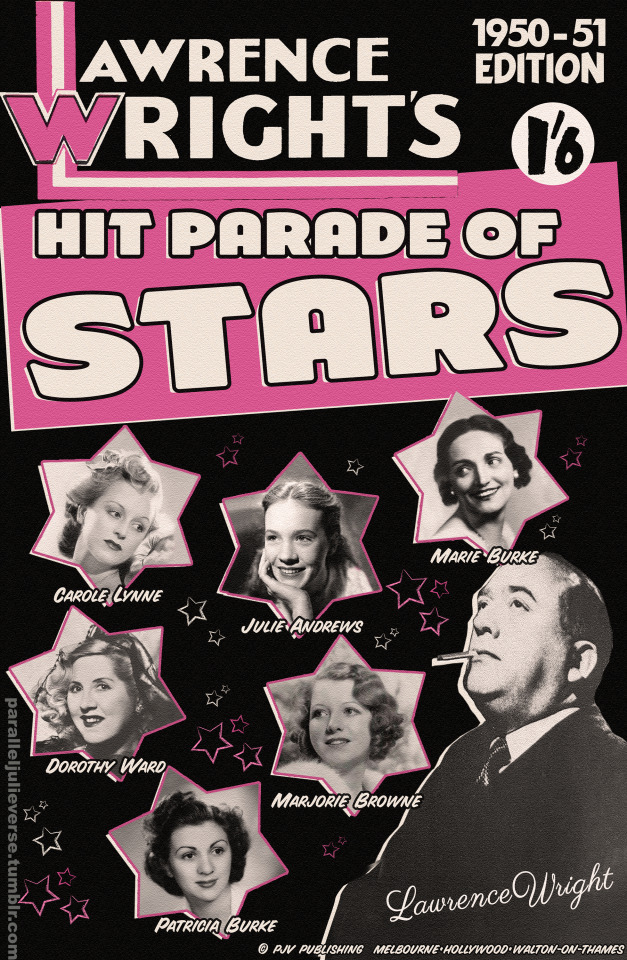
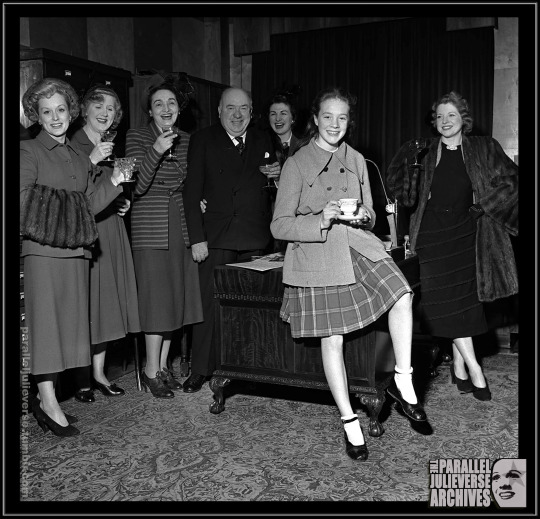
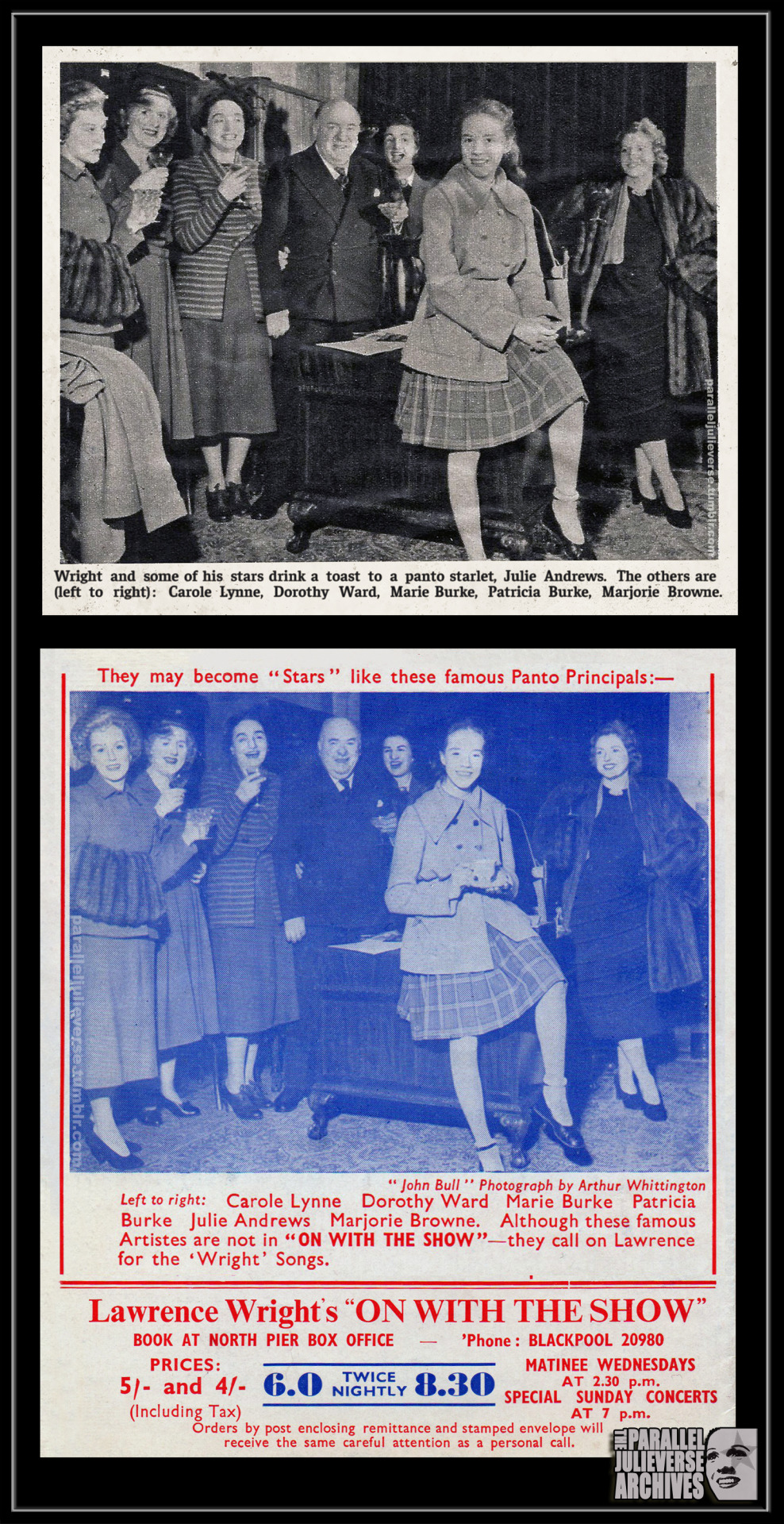

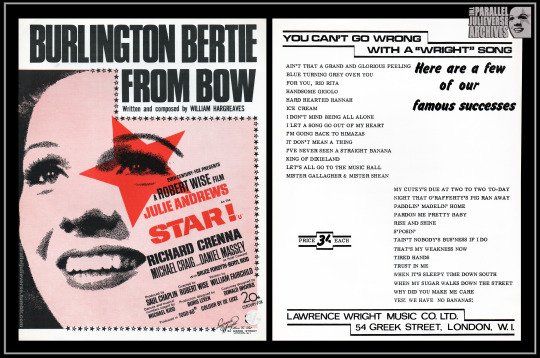
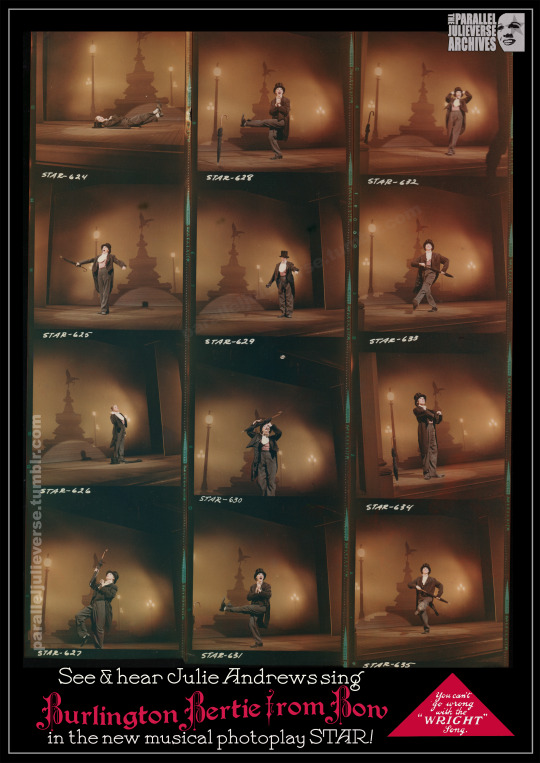
It’s been a while between posts here at the Parallel Julieverse, but we have finally managed to clear a bit of time from work, life, and other such annoyances to get back to what really matters: all things Julie! And in this post we highlight an interesting tidbit of trivia from late-1950 when Julie was appearing in Red Riding Hood at the Theatre Royal Nottingham, the subject of a recent 70th anniversary tribute post.
Although she had only just turned 15 when she was cast as the eponymous lead in Red Riding Hood, Julie Andrews was already an established juvenile star of considerable note. Her debut star-making turn as a 12-year-old child prodigy in Starlight Roof in 1947/48 garnered widespread media attention and it catapulted the young singer into a whirlwind period of touring performances, radio programmes, West End pantomimes, and even early television appearances. Julie’s subsequent casting as the resident singer in the hit BBC radio series, Educating Archie, augmented her fame further, bringing her voice into the sitting rooms of Britain on a weekly basis and making her a household name.
With this growing renown came equally expanded opportunities for cross-promotional marketing such as celebrity endorsements and advertising. A particular variant of celebrity promotion popular in the era was the staged 'star visit’ or what today might be termed ‘celebrity event marketing’ (Segrave 2005). Here the star would be invited to appear at a particular event or special occasion as a way of boosting public and media interest, while serving in return as a form of value-adding PR for the star and his/her professional ventures.
Julie was involved in several such ‘star visits’ during the three month run of Red Riding Hood. During rehearsals in mid-December 1950, she was invited as a VIP guest and honorary judge at the Annual Dance for Booth and Son, a major British apparel manufacturing company (‘Ilkeston’, 1). Around the same time, she paid a special visit to the Nazareth House for Children in Nottingham (‘Night’, 2), as well as the Borough Green Air Training Corps Cadets Open Night where “[p]art of the evening’s entertainment had to be cancelled in order to allow the enthusiastic younger generation to get her autograph” (‘Julie stopped’, 3).
One of the more fascinating such events -- and the one that we profile here -- was a courtesy visit to famed music impresario, Lawrence Wright. Today, Wright is little remembered, save by a handful of theatre history enthusiasts, but he was a major figure in the British entertainment industry of the early twentieth century (Wright 1988). Popularly dubbed the ‘Daddy of Tin Pan Alley’ and the ‘Monarch of Melody’, Wright started as a music composer in his hometown of Leicester where, under the pseudonym of Horatio Nicholls, he penned a string of popular songs such as “Down by the Stream", “Blue Eyes”, “Toy Drum Major”, and “Among My Souvenirs” (‘Alley’s Daddy’, 3).
Wright’s greatest success, however, came as a sheet music publisher and entertainment entrepreneur. In 1910, he chanced upon a catchy tune written by a local Leicester street singer called “Don’t Go Down the Mine, Daddy”. He promptly purchased the rights to the song and published it as part of his embryonic music company. A week after the song went on sale, there was a tragic mining disaster in Whitehaven in which 147 men and boys lost their lives. Recognising a potential marketing angle, Wright had a snipe printed across the top of the sheet music declaring that “Half the profits from the first ten thousand sold will go to the relief fund for the Whitehaven pit disaster” (Wright, 4). The song became a national sensation, selling over a million copies, and making Wright a small fortune. With the proceeds, he moved to London and set up shop as the ‘Lawrence Wright Music Company’ in Denmark Street, establishing what would become the city’s ‘Tin Pan Alley’.
Under the slogan, ‘You Can’t Go Wrong with the Wright Song’, Wright became the single biggest music publisher in the UK with an eventual catalogue of over 5000 songs which he leased to major theatre producers and singing artists of the day. In an era when many homes had a piano and singalongs in the parlour were a popular social pastime, Wright also sold his sheet music direct to the public through a nationwide chain of ‘Lawrence Wright Music Shops’. Ever the canny entrepreneur, Wright diversified his business holdings with a host of affiliate ventures. In 1926, he founded The Melody Maker, the first British periodical devoted to popular music, which remained in continuous publication right into the early-2000s. He launched a popular series of self-paced musical tutorials which taught a generation of young Britons how to play everything from the piano to the banjo. Wright also moved into theatre producing, mounting an annual summer revue, On With the Show at the North Pier Pavilion in Blackpool, which ran for 32 years and served as a showcase for many of the nation’s biggest variety acts (Wright 1988).
One of Wright’s more legendary professional pursuits was in the area of entertainment publicity. An inveterate showman, he would do anything to advertise his latest song or business venture, often falling foul of the authorities with some of his more colourful efforts. To promote his 1927 song, “Me and Jane in a Plane”, he chartered a bi-plane to fly at low altitude around the Blackpool Tower, while Jack Hylton and his Band played the song on board and dropped advertising leaflets to the startled crowds below. He offered £1000 to anyone who could disprove the title of another Wright song, “I’ve Never Seen a Straight Banana”, with the result that Denmark Street was awash with truckloads of fruit sent in by eager contestants. And what better way to launch a tune called “Sahara” than to dress a bevy of beautiful blondes as Arabian princesses and ride them on camels around Piccadilly Circus (Wright, 11; ‘King’, 7).
Less extravagant, but no less important to his business success, was Wright’s promotional use of stars. Across his fifty year career, Wright forged key professional relationships with many leading musical artists of the day. He even married a star: variety singer and comedienne, Betsy Warren, in 1933, though their union ended in divorce after only a few years. More enduring were his collaborations with the scores of stars who sang his songs and appeared in his shows. In 1960 to mark his 50th year in show business, Melody Maker published a special golden anniversary tribute to Wright that was brimming with congratulatory greetings from a cavalcade of stars old and new: everyone from George Formby, Jack Payne, and Billy Cotton to Harry Secombe, Connie Francis, and Frankie Vaughan (Wright, 18).
It was in this context that 15-year-old Julie Andrews found herself paying a promotional ‘star visit’ to Lawrence Wright in late 1950. The precise circumstances surrounding the visit are unknown. The young singer had an existing professional relationship of sorts with Wright, having included several of his songs in her concert repertoire such as “The Dream of Olwen” and “I Heard a Robin Singing”. Indeed, an article in the trade press from this time makes mention of Julie in relation to a newly published Wright number, “The Song of the Tritsch Tratsch” which she had started to perform in some of her concerts and, she was quoted as saying, it “always gets a grand reception” (‘Song Notes’, 4). Another likely influence behind the visit was Tom Arnold, the producer of Red Riding Hood. Arnold was a close business associate of Wright’s and one suspects he may have been instrumental in engineering the visit as a way of promoting his panto. Either way, at some point in November/December 1950, Julie dutifully trotted off to Wright’s office where, with photographers conveniently on hand, the young “panto starlet” was received by the impresario and what press reports termed a chorus of “his stars”.
It is this “chorus of stars” that makes the visit especially interesting from a theatre history perspective. While the names of the five female stars assembled to greet Julie may not ring many bells today, they were all celebrated theatrical luminaries of their day:
Carole Lynne (1918-2008): A glamorous actress and singer of the 1940s, Lynne starred in a string of big West End musicals including Black Velvet (1939), Old Chelsea (1943) opposite Richard Tauber, and a revival of Jill Darling (1945). She also appeared in a number of wartime comedy films such as Ghost Train (1941) and Asking For Trouble (1942) with Max Miller. In 1946, Lynne married famed theatre impresario, Lord Bernard Delfont -- the brother of Sir Lew Grade who would play a major role in Julie’s career -- and, after retiring from the stage in the early 50s, she became a prominent society hostess and patron to many theatre charities (’Carole Lynne’, 62).
Dorothy Ward (1890-1987): A noted beauty of the Edwardian stage, Ward rose to prominence in West End operettas such as The Dairymaids (1906) and Tom Jones (1907). She achieved her greatest fame, however, as a dashing pantomime Principal Boy, appearing in over 40 pantos across her 50 year career. In many of these shows, she played opposite her husband, Shaun Glenville, a noted panto Dame, and few Christmases passed without the pair “on the same stage, he in skirts and she in tights” ( ‘Obituary: Miss Dorothy Ward’, 14).
Marie Burke (1894-1988): A singer of remarkable versatility, Burke originally trained for an operatic career but found her niche in the lighter fields of operetta and musical theatre. She made a high profile debut as Isolde in Charles Cochran’s controversial 1919 production of Afgar, after which she spent several years touring in the United States and Australia. Burke had her greatest stage success playing the part of Julie in the premiere London production of Show Boat (1928). Thereafter, she headlined several major operettas including the London premiere of Waltzes from Vienna (1931-32) and its Broadway transfer as The Great Waltz (1934), and Don Juan de Mañara (1937) at Covent Garden. Burke had an equally successful screen career, appearing in over 70 films and TV programmes from the teens till the 1970s (‘Obituary: Marie Burke’, 12).
Patricia Burke (1917-2003) : The daughter of Marie, Patricia Burke was born in the proverbial trunk while her mother and father, tenor Tom Burke, were on a concert tour in Milan. Inevitably, she took to the boards herself as a teen, singing and dancing her way to fame in a string of West End musical successes of the 1930s -- with more than a few Julie connections. She made her professional debut in the 1933 premiere of Cole Porter’s Nymph Errant starring Gertrude Lawrence and later appeared alongside Beatrice Lillie in Happy Returns (1938). One of her greatest West End successes was as the female lead in The Lisbon Story (1943), a show which introduced the popular standard, “Pedro, the Fisherman” which Julie would later record. Following the war, Burke made an unexpected move into 'legit’ theatre, playing the female lead opposite Trevor Howard in a well received 1946 Old Vic production of The Taming of the Shrew, followed with a number of other equally high profile performances in classics such as As You Like It (1948), Jonson’s The Alchemist (1948) and Shaw’s Saint Joan (1948). Burke never forgot her popular roots, though, and she continued to alternate dramatic roles with musicals and pantos, as well as appearances in film and TV programmes (‘Patricia Burke’, p. 44).
Marjorie Browne (1910-1990): Another popular performer of the mid-century, Browne started her career in the mid-twenties as one of producer Charles Cochran’s ‘Young Lady’ beauties, scoring a major success in his revue One Damn Thing After Another (1927). Browne went on to perform widely in hit West End shows such as On Your Toes (1937) and Chu Chin Chow (1940), as well as touring productions of Rose Marie (1942-3), Hit the Deck (1944) and Good Night Vienna (1946). She also appeared in a number of British film musicals of the 30s and 40s including Lassie from Lancashire (1938), Laugh It Off (1940) co-starring Tommy Trinder, and I Didn’t Do It (1945) with George Formby.
It was, thus, quite the illustrious welcoming committee on hand to receive our young Julie. And, as much as the visit was a factitious PR event staged for the cameras by the ever-wily Lawrence Wright, there is still something deeply moving about its symbolic enactment of a generational passing of the theatrical torch. As representatives of the outgoing old guard, the five grand stars stand at the rear, poised with the confidence of a lifetime’s experience, charging their glasses in warm salute to the rising star of the next generation. That the women are bedecked with the emblematic accoutrements of mid-century celebrity -- furs, coiffure, champagne -- while, in the foreground, an adolescent Julie -- perched rather awkwardly on the corner of the desk, lanky legs akimbo -- is garbed in a homey juvenile ensemble of woollen coat, tartan skirt, ankle socks and Mary Janes -- cradling that perennial icon of cosy British domesticity, a cup of tea -- only adds to the symbolic poignancy.
By 1950, the tide was also starting to ebb for Lawrence Wright. Musical tastes were changing and audiences were fast moving on from the fireplace singalongs and end-of-pier entertainments with which he had built his career. A few short years later, he would stage his final summer revue in Blackpool in 1956, going into semi-retirement before passing in 1964 at age 76. His voluminous catalogue of songs, however, would endure. Prized as a valuable commercial property, the Lawrence Wright catalogue has been owned, at various times, by the Beatles and Michael Jackson, before being bought up by the Universal Music group (Horn, 595).
As a final Julie connection, years after her 1950 ‘star visit’ to the great man himself, Julie would once again sing a Lawrence Wright song when, as Gertrude Lawrence in the 1968 musical biopic, STAR!, she performed the classic WW1 music hall number, “Burlington Bertie from Bow”. Wright had purchased the rights to "Burlington Bertie” when it was first written in 1914 and it would remain a valuable possession of his corporate trunk. Even though “Burlington Bertie” was not in fact a song ever performed by Gertrude Lawrence, it perfectly captured the flavour of Edwardian music hall and provided an ideal showcase for Julie’s combined vocal and comic talents. The song was also something of a personal favourite for Julie. She had recorded the song previously for her 1962 album of music hall standards, and had even shared the stage in the late-40s with the original “Burlington Bertie” herself, the legendary Ella Shields (Andrews, 116). Julie’s performance of “Burlington Bertie” in STAR! would prove a highlight of that otherwise troubled film and she would continue to perform the number in concert well into the 1980s, proving indeed that “you can’t go wrong with a Wright song”!
Sources:
‘Alley’s Daddy Dead’, 1964. The Stage and Television Today, 21 March: 3.
Andrews, Julie. 2019. Home Work: A memoir of my Hollywood years. London: Weidenfeld & Nicolson.
D.G. 1964. ‘The King is Dead. Long Live the King!’, The Illustrated Chronicle. 22 May: 7.
Heyes, Joy 1991. ‘Obituary: Marjorie Browne.’ The Stage and Television Today, 21 February: 30.
Horn, David 2004. ‘Lawrence Wright Music Company’ in J. Shepherd et al, eds. Continuum Encyclopedia of Popular Music of the World : Media, industry, society. London: Continuum, pp. 594-95.
‘Ilkeston Firm’s Event’, 1950. The Nottingham Evening Post. 16 December: 1.
‘Julie stopped the show at cadet’s open night.’ 1950. The Chronicle and Advertiser. 15 December: 3.
“Night of their Lives: Children at panto. dress rehearsal’, 1950. The Nottingham Evening Post. 23 December: 2.
’Carole Lynne: Glamorous actress and musical theatre star who as Lady delfont became one of London’s leading theatrical hostesses’ 2008. The Times, 22 January: p. 62.
‘Obituary: Marie Burke’ 1988. The Times, 23 March: p.12
‘Obituary: Miss Dorothy Ward’ 1987. The Times, 22 January: p. 14.
‘Patricia Burke: Thirties musical star who proved her range with Shakespearean roles, but retained a love of pantomime.’ 2003, The Times, 27 November: p. 44.
Segrave, Kerry, 2005. Endorsements in Advertising: A social history. Jefferson, N.C.: McFarland.
‘Song Notes’ 1950. The Stage. 16 November, p. 4.
Wright, Lawrette, 1988. Lawrence Wright: Souvenirs for a century. Chards: Matthews Wright Press.
Copyright © Brett Farmer 2021
#julie andrews#lawrence wright#red riding hood#united kingdom#musical theatre#theatre history#music hall#variety#burlington bertie from bow#carole lynne#dorothy ward#marie burke#patricia burke#marjorie browne#ella shields#british
15 notes
·
View notes
Photo

Behold Dune: An Exclusive Look at Timothée Chalamet, Zendaya, Oscar Isaac, and More
Timothée Chalamet remembers the darkness. It was the summer of 2019, and the cast and crew of Dune had ventured deep into the sandstone and granite canyons of southern Jordan, leaving in the middle of the night so they could catch the dawn on camera. The light spilling over the chasms gave the landscape an otherworldly feel. It was what they had come for.
“It was really surreal,” says Chalamet. “There are these Goliath landscapes, which you may imagine existing on planets in our universe, but not on Earth.”
They weren’t on Earth anymore, anyway. They were on a deadly, dust-dry battleground planet called Arrakis. In Frank Herbert’s epic 1965 sci-fi novel, Arrakis is the only known location of the galaxy’s most vital resource, the mind-altering, time-and-space-warping “spice.” In the new film adaptation, directed by Arrival and Blade Runner 2049 filmmaker Denis Villeneuve, Chalamet stars as the young royal Paul Atreides, the proverbial stranger in a very strange land, who’s fighting to protect this hostile new home even as it threatens to destroy him. Humans are the aliens on Arrakis. The dominant species on that world are immense, voracious sandworms that burrow through the barren drifts like subterranean dragons.
For the infinite seas of sand that give the story its title, the production moved to remote regions outside Abu Dhabi in the United Arab Emirates, where the temperatures rivaled the fiction in Herbert’s story. “I remember going out of my room at 2 a.m., and it being probably 100 degrees,” says Chalamet. During the shoot, he and the other actors were costumed in what the world of Dune calls “stillsuits”—thick, rubbery armor that preserves the body’s moisture, even gathering tiny bits from the breath exhaled through the nose. In the story, the suits are life-giving. In real life, they were agony. “The shooting temperature was sometimes 120 degrees,” says Chalamet. “They put a cap on it out there, if it gets too hot. I forget what the exact number is, but you can’t keep working.” The circumstances fed the story they were there to tell: “In a really grounded way, it was helpful to be in the stillsuits and to be at that level of exhaustion.”
It wouldn’t be Dune if it were easy. Herbert’s novel became a sci-fi touchstone in the 1960s, heralded for its world-building and ecological subtext, as well as its intricate (some say impenetrable) plot focusing on two families struggling for supremacy over Arrakis. The book created ripples that many see in everything from Star Wars to Alien to Game of Thrones. Still, for decades, the novel itself has defied adaptation. In the ’70s, the wild man experimental filmmaker Alejandro Jodorowsky mounted a quest to film it, but Hollywood considered the project too risky. David Lynch brought Dune to the big screen in a 1984 feature, but it was derided as an incomprehensible mess and a blight on his filmography. In 2000, a Dune miniseries on what’s now the SyFy channel became a hit for the cable network, but it is now only dimly remembered.
Villeneuve intends to create a Dune that has so far only existed in the imagination of readers. The key, he says, was to break the sprawling narrative in half. When Dune hits theaters on December 18, it will only be half the novel, with Warner Bros. agreeing to tell the story in two films, similar to the studio’s approach with Stephen King’s It and It Chapter Two. “I would not agree to make this adaptation of the book with one single movie,” says Villeneuve. “The world is too complex. It’s a world that takes its power in details.”
For Villeneuve, this 55-year-old story about a planet being mined to death was not merely a space adventure, but a prophecy. “No matter what you believe, Earth is changing, and we will have to adapt,” he says. “That’s why I think that Dune, this book, was written in the 20th century. It was a distant portrait of the reality of the oil and the capitalism and the exploitation—the overexploitation—of Earth. Today, things are just worse. It’s a coming-of-age story, but also a call for action for the youth.”
Chalamet’s character, Paul, thinks he’s just a boy struggling to find a place in the world, but he actually possesses the ability to change it. He has a supernatural gift to harness and unleash energy, lead others, and meld with the heart of his new home world. Think Greta Thunberg, only she’s a Jedi with a degree from Hogwarts. Paul comes from a powerful galactic family with a name that sounds like a constellation—the House Atreides. His father and mother, Duke Leto (played by Oscar Isaac) and Lady Jessica (Rebecca Ferguson), take their son from their lush, Scandinavian-like home world to preside over spice extraction on Arrakis. What follows is a clash with the criminal, politically connected House Harkonnen, led by the monstrous Baron Vladimir (Stellan Skarsgård), a mammoth with merciless appetites. The baron, created with full-body prosthetics, is like a rhino in human form. This version of the character is less of a madman and more of a predator. “As much as I deeply love the book, I felt that the baron was flirting very often with caricature,” says Villeneuve. “And I tried to bring him a bit more dimension. That’s why I brought in Stellan. Stellan has something in the eyes. You feel that there’s someone thinking, thinking, thinking—that has tension and is calculating inside, deep in the eyes. I can testify, it can be quite frightening.”
The director has also expanded the role of Paul’s mother, Lady Jessica. She’s a member of the Bene Gesserit, a sect of women who can read minds, control people with their voice (again, a precursor to the Jedi mind trick), and manipulate the balance of power in the universe. In the script, which Villeneuve wrote with Eric Roth and Jon Spaihts, she is even more fearsome than before. The studio’s plot synopsis describes her as a “warrior priestess.” As Villeneuve jokes, “It’s better than ‘space nun.’ ”
Lady Jessica’s duty is to deliver a savior to the universe—and now she has a greater role in defending and training Paul too. “She’s a mother, she’s a concubine, she’s a soldier,” says Ferguson. “Denis was very respectful of Frank’s work in the book, [but] the quality of the arcs for much of the women have been brought up to a new level. There were some shifts he did, and they are beautifully portrayed now.”
In an intriguing change to the source material, Villeneuve has also updated Dr. Liet Kynes, the leading ecologist on Arrakis and an independent power broker amid the various warring factions. Although always depicted as a white man, the character is now played by Sharon Duncan-Brewster (Rogue One), a black woman. “What Denis had stated to me was there was a lack of female characters in his cast, and he had always been very feminist, pro-women, and wanted to write the role for a woman,” Duncan-Brewster says. “This human being manages to basically keep the peace amongst many people. Women are very good at that, so why can’t Kynes be a woman? Why shouldn’t Kynes be a woman?”
As fans will know, there’s a vast menagerie of other characters populating Dune. There are humans called “mentats,” augmented with computerlike minds. Paul is mentored by two of them. There are also the bravado warriors Duncan Idaho and Gurney Halleck, played by Jason Momoa and Josh Brolin. Dave Bautista plays a sinister Harkonnen enforcer Glossu Rabban, and Charlotte Rampling has a key role as the Bene Gesserit reverend mother. The list goes on. In the seemingly unlivable wilds of Arrakis, Javier Bardem leads the Fremen tribe as Stilgar, and Zendaya costars as a mystery woman named Chani, who haunts Paul in his dreams as a vision with glowing blue eyes.
The breadth of Dune is what has made it so confounding for others to adapt. “It’s a book that tackles politics, religion, ecology, spirituality—and with a lot of characters,” says Villeneuve. “I think that’s why it’s so difficult. Honestly, it’s by far the most difficult thing I’ve done in my life.” After finishing this first movie, he’ll just have to do it all over again.
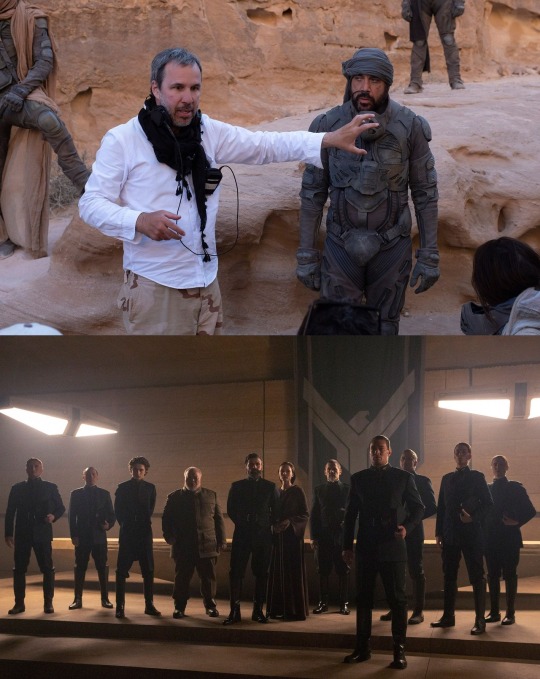
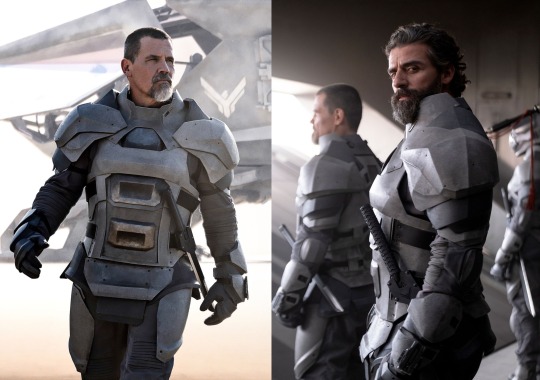
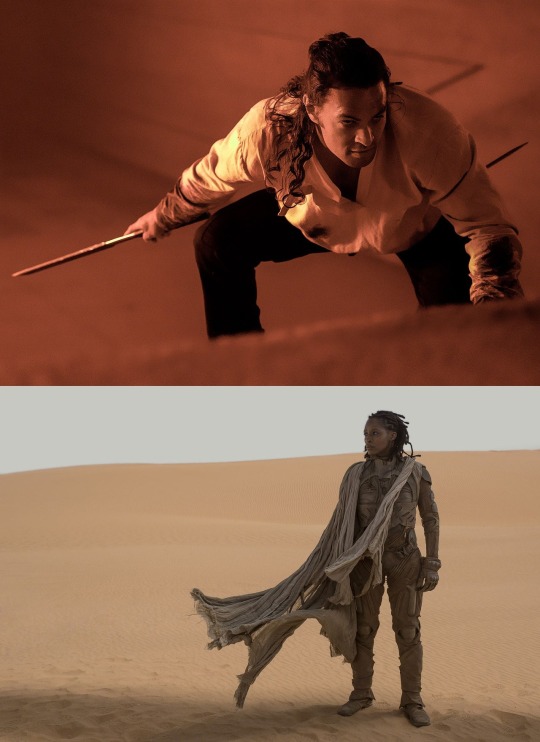

#timmy#timothee chalamet#dune 2020#paul atreides#denis villeneuve#zendaya#Rebecca Ferguson#Oscar Isaac#Josh Brolin#my edit
654 notes
·
View notes
Text
Anyways, before I finished DRV3 I had seen a couple spoiler-adjacent fanworks and had thought the game was going to end up being some sort of VR experience, so here’s my AU pitch:
Modern-adjacent setting but obviously with much, much better technology. Dangan Ronpa is an augmented Virtual Reality game where you can pop in and play more or less a murder mystery with your friends, and there’s a variety of modes, including sandbox that unlocks after everyone has done a tutorial where you can straight up create new backstories and memories for everyone and clown around.
So the cast of DRV3 is just like. A group of friends who stream a lot of Dangan Ronpa. Keebo saw ‘Ultimate Robot’ as a choice in the list of characters was like ‘is anyone going to choose that’ and did not wait for an answer and is basically always the Robot and when the gang figured out how to integrate twitch chat into the game, is basically always the chat surrogate. (They tried to give almost everyone a shot, but fully half the cast would just ignore the chat, a handful would almost always do the opposite of the suggestions out of spite, Himiko would listen and talk back but almost always was too lazy or bored to follow orders, and Shuichi almost caused the game to overload trying to figure out where these voices were coming from and what they wanted, all of which was funny in its own way, but ultimately Keebo is the best option for when they want chat to have a say in events)
The games normally have like, a DM equivalent role where the person keeps their memories and can manipulate parts of the game and tries to keep the plot moving along. Generally they also try to maintain a low-key persona as well, because the default if the mastermind dies is to just shut down the game, but there is a not insignificant amount of streams dedicated to killing off the mastermind on purpose, and then watching absolute chaos ensue as the learning AI in the game tries desperately to keep things chugging along, sometimes to hilarious outcomes (i.e. the AI built to make a creation jump the furthest distance just building an extremely long leg and falling, sometimes the AI decides to best conduct a murder mystery it should just terminate all but two players or one crazy stream where the AI decided the best motive to a killing game would be the end of the killing game and got stuck in a logic loop for a while).
Tsumugi is definitely one of the most popular DMs, and Kokichi is mostly banned bc the games he DMs are either WAY too intense or devolve into mostly random prank battles and silliness. In any case, the events of DRV3 were mostly planned together by the group and everyone more or less gets to choose their own talents, although the DM is largely in charge of the backstories and overarching plot elements. Kaede in the real world like classical music but absolutely threw over her piano lessons in favor of screwing around with her friends at the arcade and thus thought Ultimate Pianist was the funniest possible choice. Ryoma and Tsumugi worked together to get him *two* Ultimate titles, also because they thought it was needlessly overdramatic and funny.
After an execution or death, the player drops out and can continue to watch events unfold through the still alive characters’ viewpoints. The pain is also dulled WAY down in real life so as to lessen the absolute trauma that might bring about. Rantaro throws an understated fit when he is the first to drop out as chat teases him because he was really excited about this character. (”Kaede this was going to be the one! Look at this backstory!” “Okay, I’m sorry, but have you considered literally talking to anyone about any of your plans, ever?” “Absolutely not.”)
Ryoma pops out furious bc Tsumugi gave him in game depression *again* and while it is more or less an ongoing joke at this point, he’s sick of it! Where are his in game anti-depressants huh? He has rights! Kirumi, in contrast, almost makes herself sick laughing when she exits the game, because what was that? Her mom vibes had transcended the walls of reality and her in game character had *hated* it. She really thought she was simultaneously the most and least important person in the world. Wild. She says hey to chat and then drags Rantaro and Ryoma to stress bake with her while Kaede continues to monologue about how lucky they are Shuichi hasn’t died yet bc he is the *only one* who can deduce *anything* in this particular game it seems.
Angie comes out pouting bc she had jokingly made a cult in the last game she DM’d and it wasn’t *her* fault Tsumugi’s character had fallen head over heels for it! She had dimensions! And she was absolutely going to own Tsumugi in Mario Party later for making the island she grew up on seem weird. So they didn’t do things exactly like the mainland, that didn’t mean everyone was constantly having orgies or murder parties or whatever! Tsumugi!!!!! She is in the middle of starting an art stream on the side while ranting to chat, largely to a mixture of laughing emojis and sincere agreement when Tenko pops out, blinking and confused.
Tenko, who definitely knows *some* martial arts and is in shape but does not know what Neo-Akido is supposed to be, demands they roll back the tapes and when Angie dead-pan informs her they don’t have that ability, angrily munches on the fresh baked cookies and mumbles about how Tsumugi is homophobic for not letting her kiss Himiko even *once* this game. Kaede reminds her last game she and Himiko had a pre-canon relationship and got to kiss all the time, and also are literally dating, to no apparent effect.
When Korekiyo comes blinking out of the game he’s almost immediately like “Oh, come on!” Bc he had jokingly insulted Tsumugi the other day and essentially said they could replace her with a cardboard cut out to no noticeable difference and when she had shot back that he had no place to talk he clearly bought all his clothes at a Hot Topic in place of a personality, he’d thought they were good. OBVIOUSLY NOT! Korekiyo had said that thing about his sister being in and out of the hospital in CONFIDENCE and ALSO it was because she kept breaking her bones bc she fully refused to stop climbing on top of things and jumping off full speed. She was fine! She had a lovely wife now who managed to stop her from breaking any more bones at LEAST 80% of the time. Why did Tsumugi have to do him dirty like this? She knew his sister watched these streams and was also probably texting him overdramatically outraged and grossed out messages right this second. Uncool. (”It’s because you presented on tracking recessive genes through the royal family’s family tree last PowerPoint party” Angie informs him, unsympathetically. “Genetics are fascinating and monarchies are stupid” Korekiyo wails in response).
Miu returns from the game more or less shrugging, she should’ve known better than to try to kill Kokichi, but in her defense it would’ve been *really* funny if she managed. Everyone agrees, and chat consoles her with sad pog emojis. Gonta follows shortly after, absolutely sobbing that he’s sorry as he does every time he manages to kill someone, and being awkwardly patted on the back by Miu as she reminds him it was just a game and not a big deal. After he is consoled he does straighten up indignantly and reminds everyone, much to their amusement, that he stopped wanting to run off and live in the woods with wild animals when he was like, eight, and realized it would probably be not constructive to their way of life, and also he would *never* let a bunch of insects out in a room full of nervous people who could potentially swat at them and harm them. Kaede sets him up an animal facts side stream and they all leave him to it. At some point his and Angie’s streams kind of merge into one as she draws him little simplified bugs and animals and he points out their special features and talents and everyone agrees it is good.
Kokichi then pops out of the game to much groaning and annoyance as he ruined the mystery for the already ‘dead’ players and is shooed out of the room as half of chat demands to know which of the two is actually dead and half of chat demands the surprise not be spoiled. When he’s allowed back in after the reveal, it’s to begrudging praise for managing to make such a convoluted plot without his memories and being forced to apologize to Gonta by Kirumi, which he does, albeit pouting his way through it (”Uh, shouldn’t he be apologizing to ME?” Miu demands, waving her hand in the air. “You literally tried to kill me first” Kokichi shoots back, deadpan, before returning to Gonta).
Kaito is lauded as he comes out of the game, Kokichi complains about his ad-libs, but largely everyone is impressed by his bringing everyone together, hiding the secret illness Tsumugi tagged him with, and managing to follow along Kokichi’s extremely wild plan. Kaito, on the other hand, is bemoaning being the Ultimate Astronaut once again (”It was an elementary school phase! Everyone wanted to be an astronaut in elementary school! Why does she keep making it *my* problem???”).
They all take another stress-bake break while nervously watching the screens as their remaining friends have what seems like some sort of nervous breakdown. The game engine has a stress meter, and Tsumugi herself can end the game whenever she thinks it’s going too rough (A good measure, although another reason Kokichi is in DM timeout, bc he would slam the eject cast button anytime things went too far off the rails of his desired plot and his metric for ‘too far off the rails’ fluctuated wildly depending on his mood), but it’s still not fun to see your friends so upset, even if it is just a game.
Finally after much excitement watching Shuichi run around wildly and Keebo tear everything to the ground, the gang watches the final trial commence. They groan and cheer and comment as Shuichi and Tsumugi lay out the final elements of the plot (”Tsumugi jumped the shark *so hard* on this one and I’m going to give her *so much* crap for that *and* getting me killed for no reason” Kaede complains after the sixth or seventh outfit switch Tsumugi pulls). They set up the final poll and watch in awe as Shuichi argues and beseeches and tries so hard to save this world that isn’t even real. The whole hope v despair thing is a little trite, and honestly, refusing to pick a side isn’t *that* rare of an outcome, but watching Shuichi lay out a case and argue so passionately is always inspirational.
Keebo and Tsumugi pop out at the same time, to much teasing and cheering and excitement. Keebo cuts through eventually as people are teasingly tearing into Tsumugi’s plot as she pouts and whines and defends herself to point out the epilogue playing out on screen. Maki, Himiko, and Shuichi made it past the sixth trial, so they get a little ending to themselves before the game shuts down. The casual optimism makes everyone roll their eyes at the cheesiness, but in a good way, good naturedly jeering about how they thought the winners weren’t choosing despair OR hope. But as it dies down and credits start to play on the stream, they welcome the three back from the game cheerfully anyways.
#danganronpa#dr#drv3#yet another overly wordy au idea from me#this is probably stupid but i like it and thats whats important lads#side notes I couldn't quite fit in:#i think shuichi himiko and weirdly enough kokichi have the lowest kill count over the streams#shuichi gets real squeamish#himiko is frankly a little lazy and doesnt really like to put the effort into the game and also is squeamish#and kokichi does have a moral code albeit one known only to himself lol#gonta also has a pretty low count but unfortunately hes pretty easy to trick or convince into these things even though he always feels#awful about it afterwards :(
3 notes
·
View notes